|
A Family Resemblance and the Veritas connection |
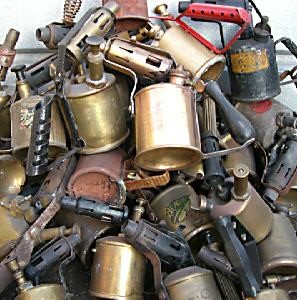 |
Back to the Blowlamp Homepage |
|
Contents and summary |
|
Manufacturer |
Brand / Trade / Retailers Name(s) |
Notes |
|
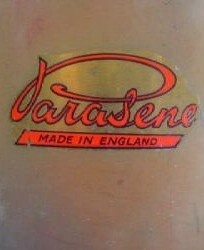
|
Dudley Road, Halesowen, West Midlands, B63 3LR
|
Parasene Plumbob Blowlamps with the Moon and Stars logo Stirling |
M H Berlyn (Parasene) blowlamps were also sold under the name Plumbob (Thomas Plant Ltd); blowlamps with the "Moon and Stars" logo, and the retailer Stirling. Believed also to have produced blowlamps for Falk, Stadelmann & Co Ltd, which sold under the Veritas / Falks brand name.
|
|
|
Phoemax (Ludlow) Ltd Phoemax Works, Temeside, Ludlow
The Swedische Lamp Co Little Sweden, Ludlow |
Phoemax Duo-Burn (Swedische Lamp Co, Little Sweden, Ludlow) |
Meads Brothers blowlamps were sold under the name Phoemax. The Swedische Lamp Co, with the brand name Duo-Burn, almost certainly had a connection with Meads Brothers, but this remains unconfirmed. Believed also to have produced blowlamps for Falk, Stadelmann & Co Ltd, which sold under the Veritas / Falks brand name.
|

|
R & M Mfg & Engineering Co Ltd Lion Works, Stanhope Street, Birmingham 12 (Robins & Malin?) |
R M Heathware COB? |
R & M Manufacturing & Engineering Co Ltd were bought out in 1950 by Samuel Heath & Sons Ltd, who continued to sell blowlamps under the R M name, but with the addition of the Heathware brand / trade name. Believed also to have produced blowlamps for Falk, Stadelmann & Co Ltd, which sold under the Veritas / Falks brand name. R M blowlamps possibly also sold under the "COB" name. |
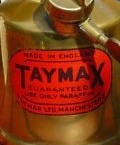
|
Manchester 3 / 100 Barbirolli Square, Manchester M2 3EY |
Taymax Two Tiger (Fletcher Hardware) Nordic? |
Taymar blowlamps were sold under the name Taymax and also the name Two Tiger (Fletcher Hardware) and possibly the name Nordic. Fletcher Hardware were a Birmingham based retailer and ironmongery supplier. The name "Nordic" appears on a stick on label on the tank of a blowlamp almost certainly manufactured by Taymar Ltd. |
|
|
Appendix: Falk, Stadelmann & Co Ltd |
||
|
M H Berlyn Co Ltd Dudley Road, Halesowen, West Midlands, B63 3LR |
||||
|
Associated brand / trade / retailers name(s): Parasene, Plumbob, Stirling, and blowlamps with the Moon & Stars logo. Believed also to have produced standard paraffin blowlamps for Falk, Stadelmann & Co Ltd (Veritas) (See below). |
||||
|
M H Berlyn Co Ltd (latterly M H Berlyn Ltd) was founded in 1905, and apart from blowlamps had at various times manufactured greenhouse heaters, camping stoves etc, although the production of paraffin blowlamps and pressure stoves did not commence until, probably, the 1950s / 1960s. The company was thought to have been dissolved in c2008, although products, notably paraffin garden heaters, still appear for sale under the Parasene name. Paraffin blowlamp production may have continued to the early 1990s; a very late date for this type of blowlamp. See "later" examples, particularly dated examples with a military specification below. |
||||
|
|
||||
|
M H Berlyn Co Ltd: Parasene examples |
||||
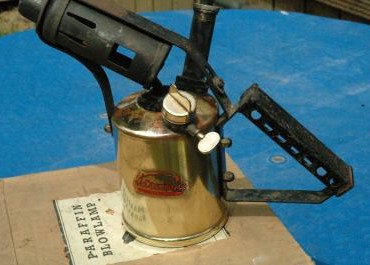
|
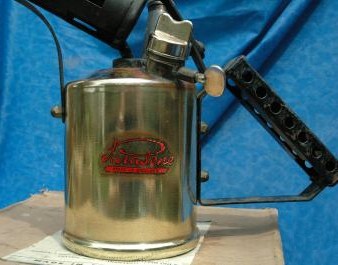
|
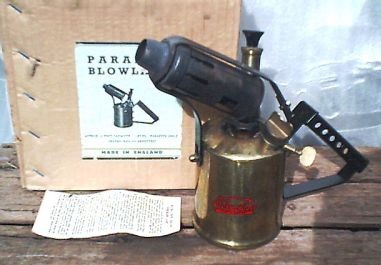
|
||
|
Above, Parasene pint size paraffin models with characteristic features including the black painted steel handle with 7 holes, the top and bottom of which was said to have been closed by spot welds, and the two domed nut fixing of the handle to the tank. Also standard features are the plastic / bakelite pump knob, the distinctive plain pattern filler cap, and (on pint models) the two-piece burner. On the above examples note also the earlier (possibly pre-1970) conventional burner support bracket, as opposed to that on the later quart model and pint models shown below, which have a simplified burner support bracket at just the front end of the burner tube, similar to all half-pint models. |
||||
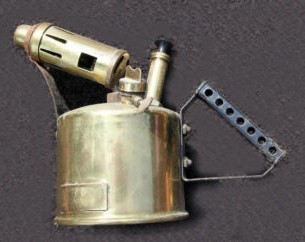
|
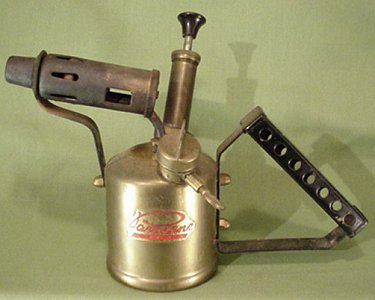
|
|
||
|
Parasene quart (2 pint) paraffin model, with the same characteristic features. This quart size example is probably a later model (as in the case of the examples immediately below) with the simplified burner support bracket. The quart size is a rare find for any of the manufacturers described in this article. |
Parasene half-pint paraffin example. Once again with the same features described above for the pint models, although note that burner tubes on all half-pint models were one-piece, and the burner support bracket was of a simplified form, also typical of all half-pint models. |
Parasene advert dated 1970, click on to enlarge. Note the two models shown are numbered 400L (pint) and 400S (half-pint). (Source, PHILIPPE TOUILLET Book of British Blowlamps)
|
||
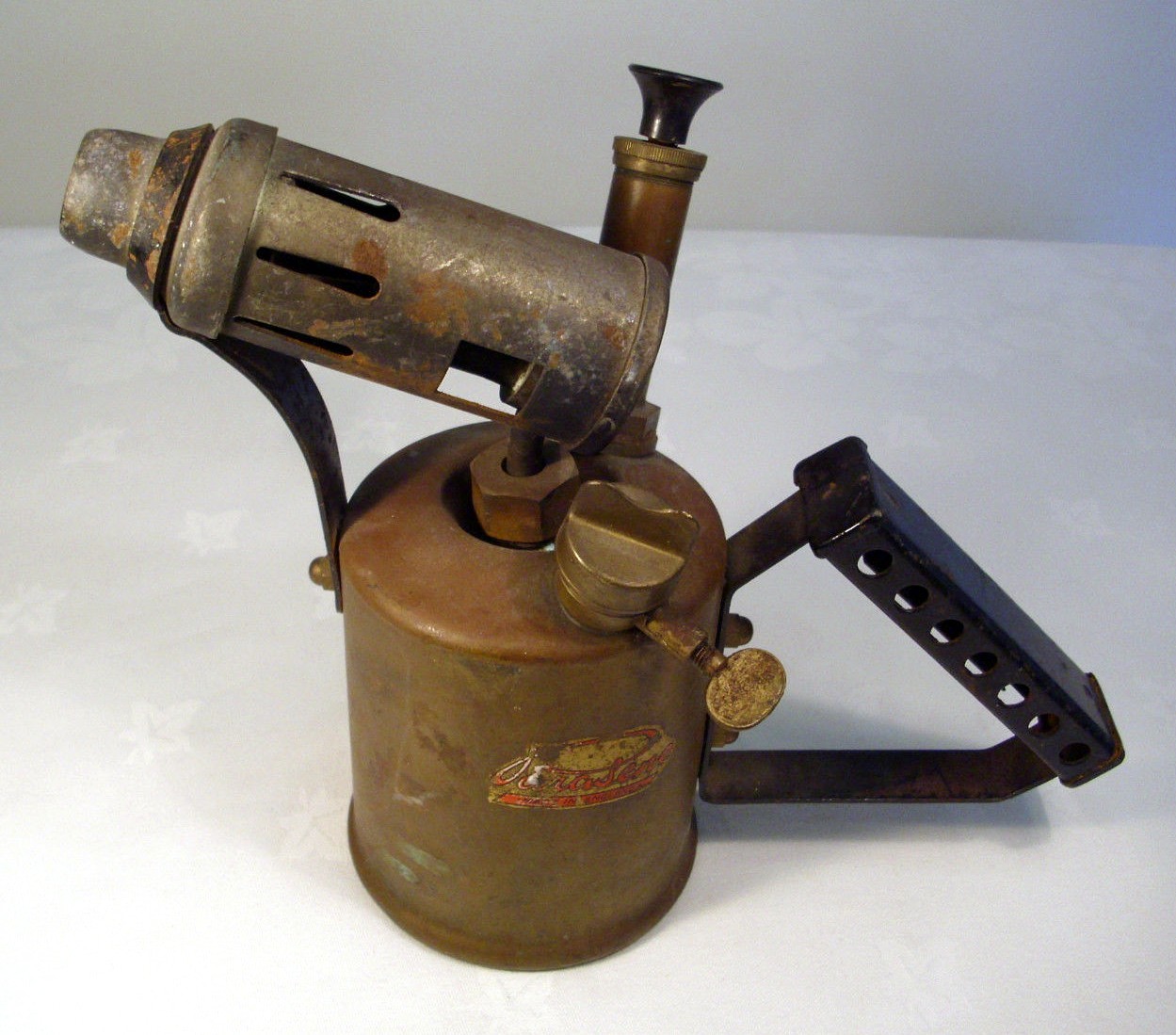
|
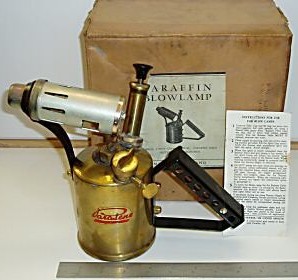
|
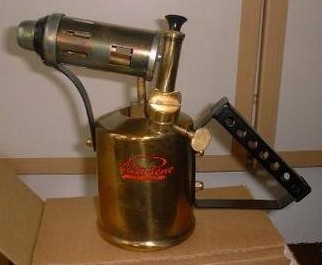
|
||
|
Above: Parasene examples, probably of later manufacture, with the characteristic features, and the simplified burner support bracket. Note also that the burner tubes on some of these models have the appearance of being made from steel. |
||||
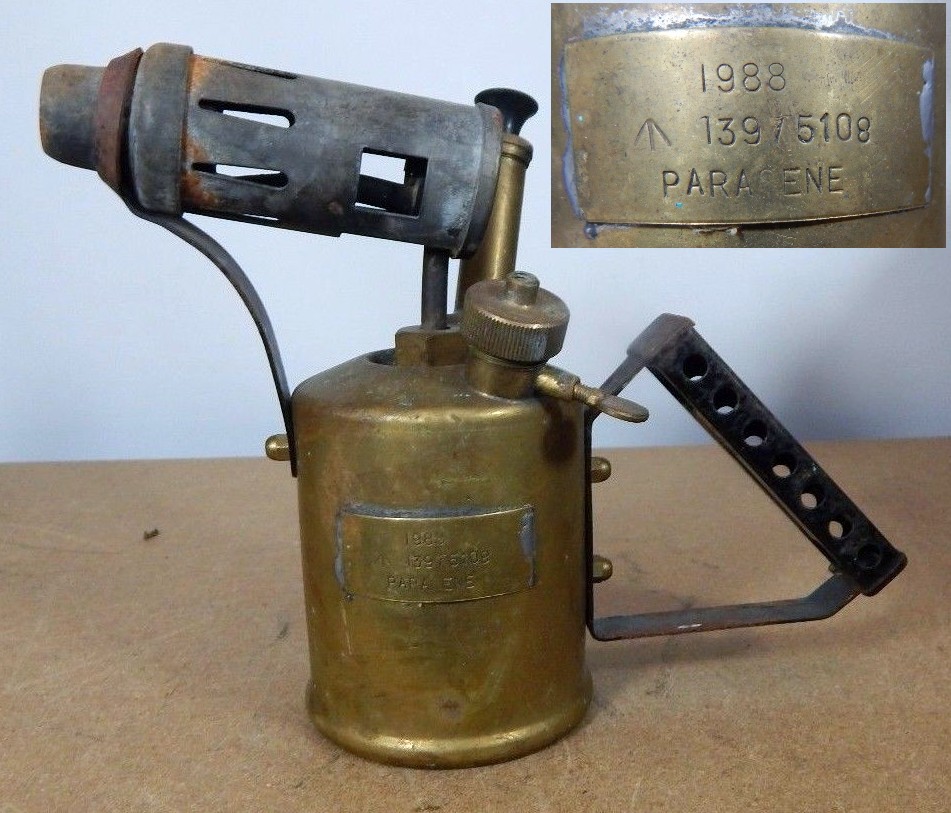
|
|
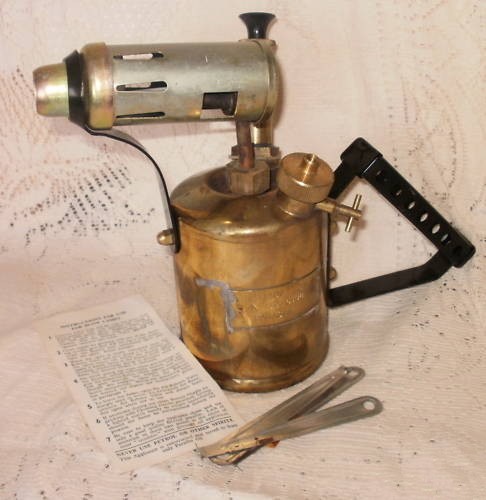
|
||
|
Above are three more Parasene pint paraffin examples, certainly of later manufacture and also to military specification. Each example has a soldered-on plate to the tank. The example left (click on to enlarge) has the military broad arrow mark, the name PARASENE, the date 1988 and the number 139/5108. On the example in the centre is a similar plate said to be dated 1979. The date for the example on the right is unknown, although an identical example (but without the soldered-on plate) has been seen with the date 1992 stamped into the top of the burner tube, together with the military broad arrow mark, the name PARASENE and the number 139/5108, the same markings in fact as on the plate on the example to the left; note also the different style of pressure release screw on the example to the right, like a small T-bar. The simplified burner support bracket is seen on all three examples. Although it is not known when production of Parasene blowlamps ceased, it would appear therefore to have been as late as 1992. Note also in the case of these three examples the different type of filler cap, which incorporates a pressure release valve, almost certainly as part of a military specification. |
||||
|
M H Berlyn Co Ltd: Examples with the "Moon & Stars" logo |
|||
|
Presumably, the Moon & Stars logo represented what is to date an unknown retailer or supplier. The half-pint examples below can be said with some certainty to have been made by M H Berlyn; the same can be said about the pint examples, although with reservations as noted under each of the two examples. |
|||
|
|
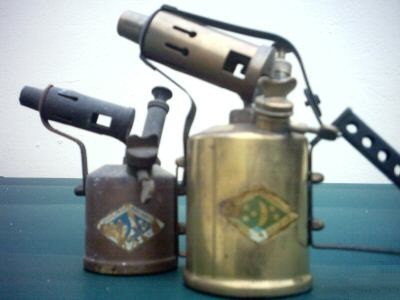
|
|
|
|
Above, a half-pint size "Moon & Stars" example with all the indications of having been manufactured by M H Berlyn Co as comparison with the Parasene examples above show. |
Above, a half-pint "Moon & Stars" example on the left. The pint example is an odd one. The handle is Parasene-like, but note the one piece burner, and a different filler cap. Another maker? Or replacement parts from another blowlamp? |
This pint example has all the features of a Parasene, but note the different form of the handle (it has just four holes) and a fixing rod or spindle through the length of the handle. Click on the left hand picture to enlarge. This same form of handle can be seen on a Veritas half-pint example. See below. |
|
|
Meads Brothers, Ludlow / Phoemax Ludlow Ltd Phoemax Works, Temeside, Ludlow Swedische Lamp Co Little Sweden, Ludlow |
|||||
|
Associated brand / Trade / Retailers Name(s): Phoemax, Duo-Burn (Swedische Lamp Company?). Believed also to have produced standard paraffin blowlamps for Falk, Stadelmann & Co Ltd (Veritas) (See below). |
|||||
|
Note: Despite extensive inquiries to Ludlow local authority, library and historical societies, no record appears to exist of Meads Brothers, the Phoemax Works, or the Swedische Lamp Company. |
|||||
|
A partnership comprising Harry John Meads, and Ethel Meads (the wife of Albert West-Meads) operated under the name Meads Brothers at Phoemax Works, Temeside, Ludlow, thought to be from the early 1950s. The name Meads Brothers never appeared on any products (as far as is known). It has been suggested that the business went under the name Phoemax (Ludlow) Ltd from around 1955, at which time they were listed as “pressure oil appliance manufacturers”. The Meads Brothers factory was said to have closed in 1960, or the "1960s". That it produced blowlamps for Falk, Stadelmann & Co Ltd is strongly suggested by the reports firstly, that Veritas blowlamps were made in Ludlow up until 1960, and secondly, that Veritas blowlamps probably represented the major part of production. Not only that, some examples of both Phoemax and Veritas blowlamps have their name within a diamond, stamped into the tank, also suggesting a connection. See below and Falk, Stadelmann & Co Ltd. See also the London Gazette extracts for 1955 and 1969, and the Edinburgh Gazette (Bankruptcy) 1953 extract. (Albert West Meads v The King). Patents Two patents are ascribed to Harry John Meads and Albert West-Meads; GB695742, an invention to facilitate the use of a blowlamp in an inverted position, and GB708053, a paint removal too which fitted the end of the burner tube; see example below. Harry James Meads (a relation?) and Parkinson and W & B Cowan Ltd (later Monitor) had three patents ascribed: GB234622 (Locking pump); GB410885, "Improvements relating to oil burner stoves", and GB524395 (Safety valve). The locking pump (GB234622) was fitted to certain models of blowlamp of a number of manufacturers; known examples are: Monitor, John Shaw & Sons (Governor), Samuel Heath & Sons, and Wrights of Lymm (Wrights of Lymm were probably by T E Bladon). Where the locking pump was fitted, the blowlamps were generally to military specification, which also had a combined filler cap / safety valve, or in the case of Wrights of Lymm, a separate safety valve, as patent GB524395. This particular combination of locking pump and safety valve was seen primarily throughout the period of World War 2. The aforementioned type of safety valve (patent GB524395) was, as well as being fitted to Wrights of Lymm models, also fitted to certain models of blowlamp by Monitor, John Shaw & Sons (Governor), and also notably T E Bladon, Birmingham. The safety valve was fitted into the tank side or sometimes, the top, depending on the model. The Swedische Lamp Co, Little Sweden, Ludlow. A pint paraffin blowlamp has the name “Duo-Burn by Swedische Lamp Co” on its label (below). By all appearance, it is a Phoemax half-pint model, strongly suggesting a Ludlow connection, and an assumed connection with Meads Brothers, but this (or any details) remains unconfirmed. Duo-Burn paraffin pressure stoves. Duo-Burn paraffin pressure stoves were thought to have been retailed under the Veritas name (see Classic Camp Stoves website, for example the Falk, Stadelmann & Co link). |
|||||
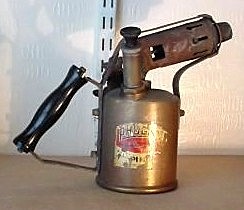
|
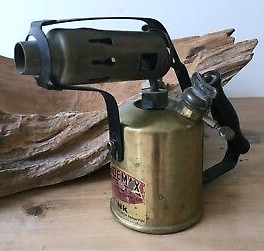
|
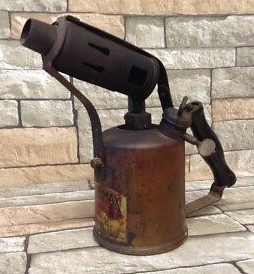
|
%20Advert%20c1956.jpg)
|
||
|
Phoemax pint examples. Note the "smoother" or more rounded contour to the bakelite / plastic handle, as opposed to the faceted type used on the half-pint models. See below. The handle is secured to the bracket with domed nuts, but note the two plain nut fixing of the handle bracket to the tank. The pump knob is of bakelite / plastic. On the pint examples shown the filler cap is of a plain, though fairly distinctive form. |
Phoemax (Ludlow) advertisement c1956. Click on advert to enlarge. |
||||
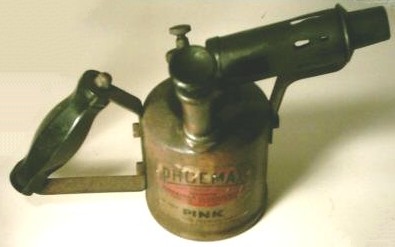
|
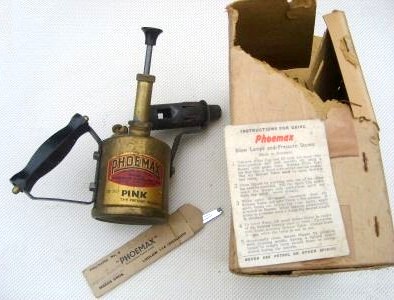
|
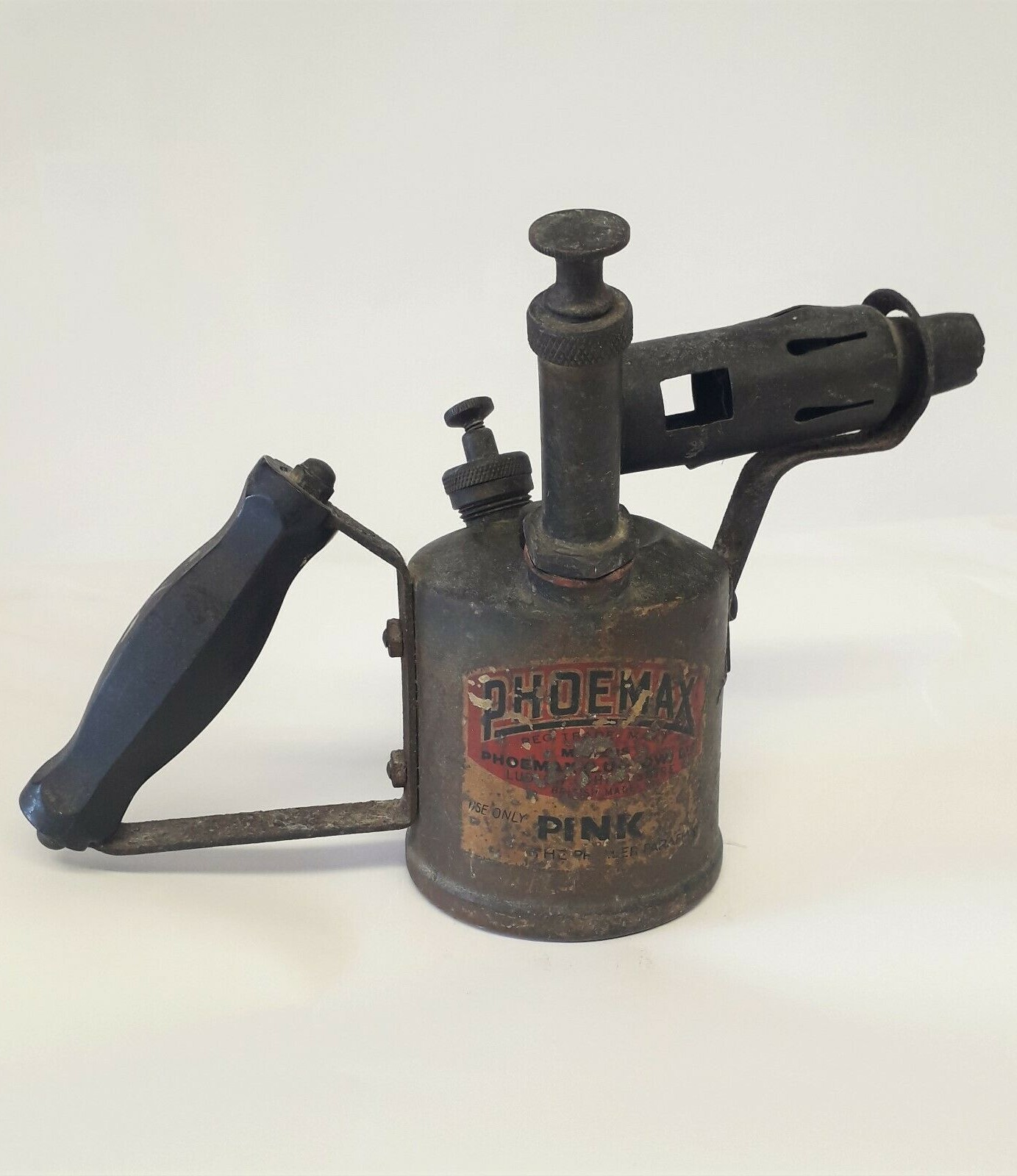
|
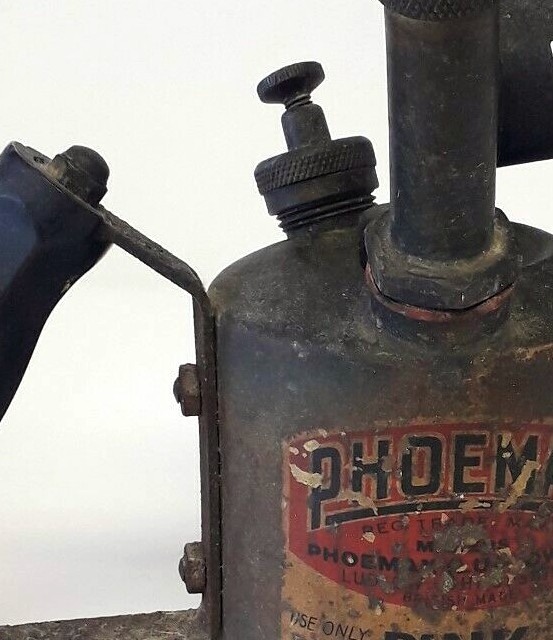
|
||
|
Phoemax half-pint examples which have a characteristic combined filler cap / pressure release screw. As with the pint examples there is a bakelite / plastic handle, secured with domed nuts, as well as the two plain nut fixing of the handle bracket to the tank; and the bakelite / plastic pump knob. These features can also be seen in the Duo-Burn example below, and the associated Thomas P Headland Ltd tools catalogue page. |
|||||
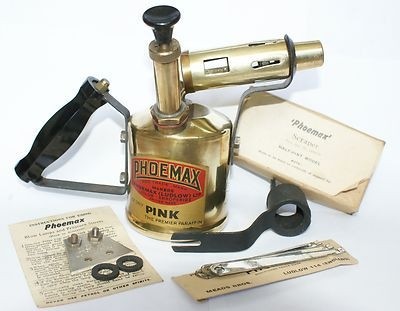
|
|
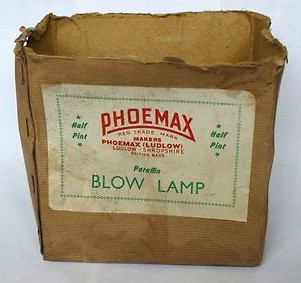
|

|
||
|
Phoemax half-pint example with spares and accessories including the patented paint scraping attachment. Click on photo to enlarge. |
Phoemax (Ludlow) label. |
Phoemax (Ludlow) examples of boxes with labels. |
|||
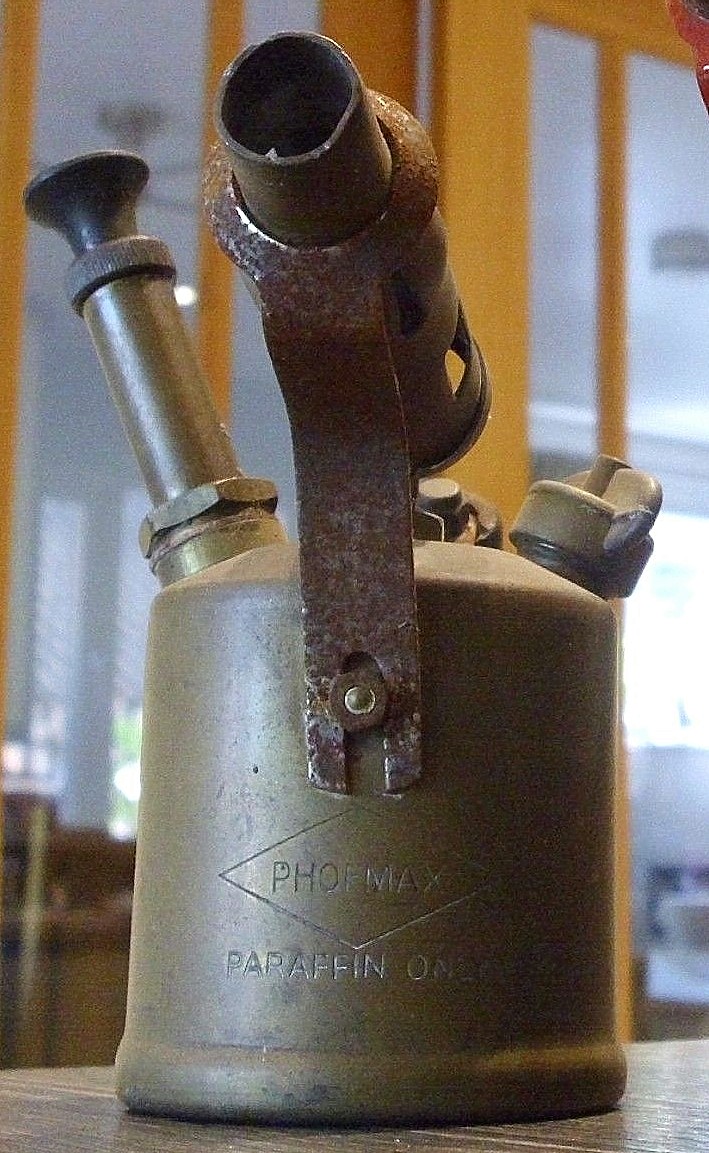
|
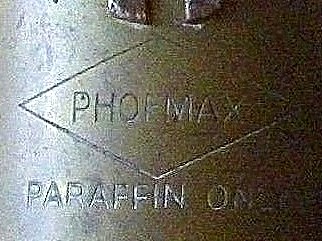
|
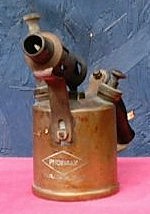
|
|
||
|
Two examples of Phoemax half-pint models with the name inside a diamond shape, pressed into the tank. The example to the left has a different type of filler cap to the standard type described for Phoemax half-pint models, and so is possibly a replacement. See also the "Veritas" example with similar impressed mark. This might suggest a link, albeit tentative, between Phoemax and Veritas. |
Phoemax adverts* including the patented paint scraper. Adverts dated to the 1950s, click to enlarge. (Source, PHILIPPE TOUILLET Book of British Blowlamps) |
||||
|
*For reasons unknown, the blowlamps depicted in these advertisements appear to have steel handles like those fitted to M H Berlyn Co (Parasene) examples, and some examples made for Falk, Stadelmann & Co Ltd (Veritas). |
|||||
|
R & M Manufacturing & Engineering Co Ltd Lion Works, Stanhope Street, Birmingham 12 |
|||
|
Brand / Trade / Retailers Name(s): R M / Heathware / COB? Believed also to have produced standard paraffin blowlamps for Falk, Stadelmann & Co Ltd (Veritas) (See below). |
|||
|
R & M Manufacturing & Engineering Co Ltd were formed in 1946, and were said to have had a factory capable of making stoves and blowlamps; it has been suggested that they ceased the production of blowlamps as early as 1960? R & M were bought out in 1950 by Samuel Heath & Sons Ltd although blowlamps continued to be produced and sold under the R M name (with the addition of the Heathware brand / trade name, see below) or under the Thermidor name. See examples below. References to the company and their connections with Samuel Heath & Sons Ltd (up to the present time) are to be found on the internet, for example: https://beta.companieshouse.gov.uk/company/00407916 Flamus Oil Accessories Co There is an advertisement for R & M blowlamps, dated 1951, which includes a reference to the Flamus Oil Accessories Co at the Stanhope Street, Birmingham address. See https://www.gracesguide.co.uk/File:Im1951Benn-Flamus.jpg This suggests a link between R & M and the name Flamus, but nothing more is known. The advert in question can be compared with the R & M advert below right, which has a reference in brackets "Incorporating Flamus Oil Accessories Co". Robins & Malin R & M is thought by some to have been the initials for Robins & Malin, but this has never been established. |
|||
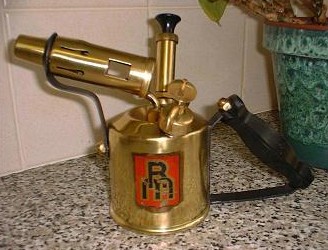
|
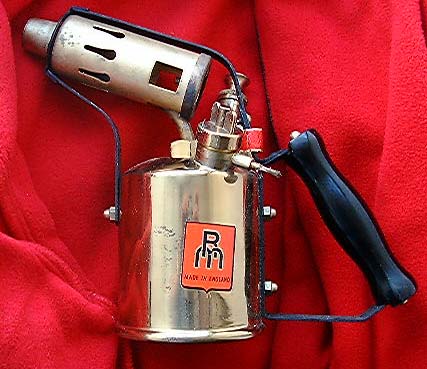
|
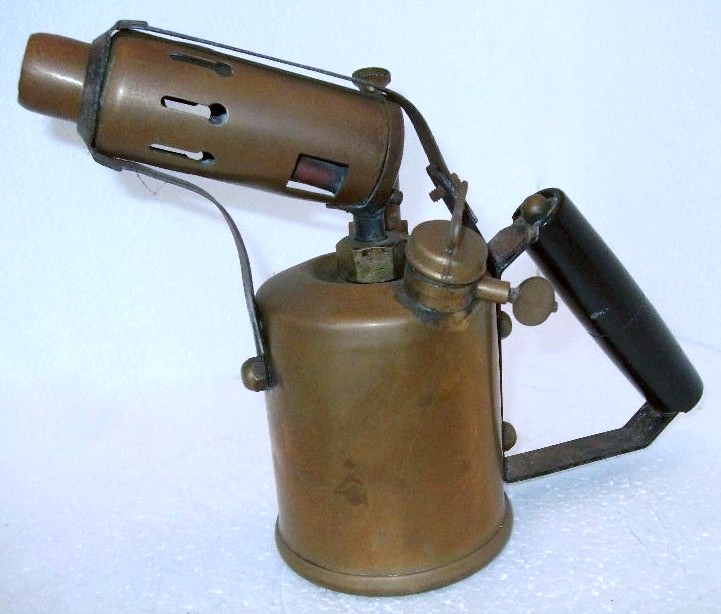
|
|
|
R M half-pint (left) and pint examples. The distinctive combined filler cap and pressure release screw appears to be a feature common to all half-pint models, whilst different forms of filler cap appear on pint models. Examples (both pint and half-pint) have either a bakelite / plastic or a brass pump knob. On the pint examples seen above and immediately below, some handles are soldered to the tank, whilst others are fixed with domed, or even plain nuts. |
Probably a later model(?) (numbered 2034, impressed into tank) with different format handle. This model can be seen in the advert link immediately below right; the page with this example is dated 1960. The example shown above may well have had an R M logo originally. There is an identical example with a Veritas label, see below, suggesting a link between R & M and Falk, Stadelmann & Co Ltd (Veritas) |
||
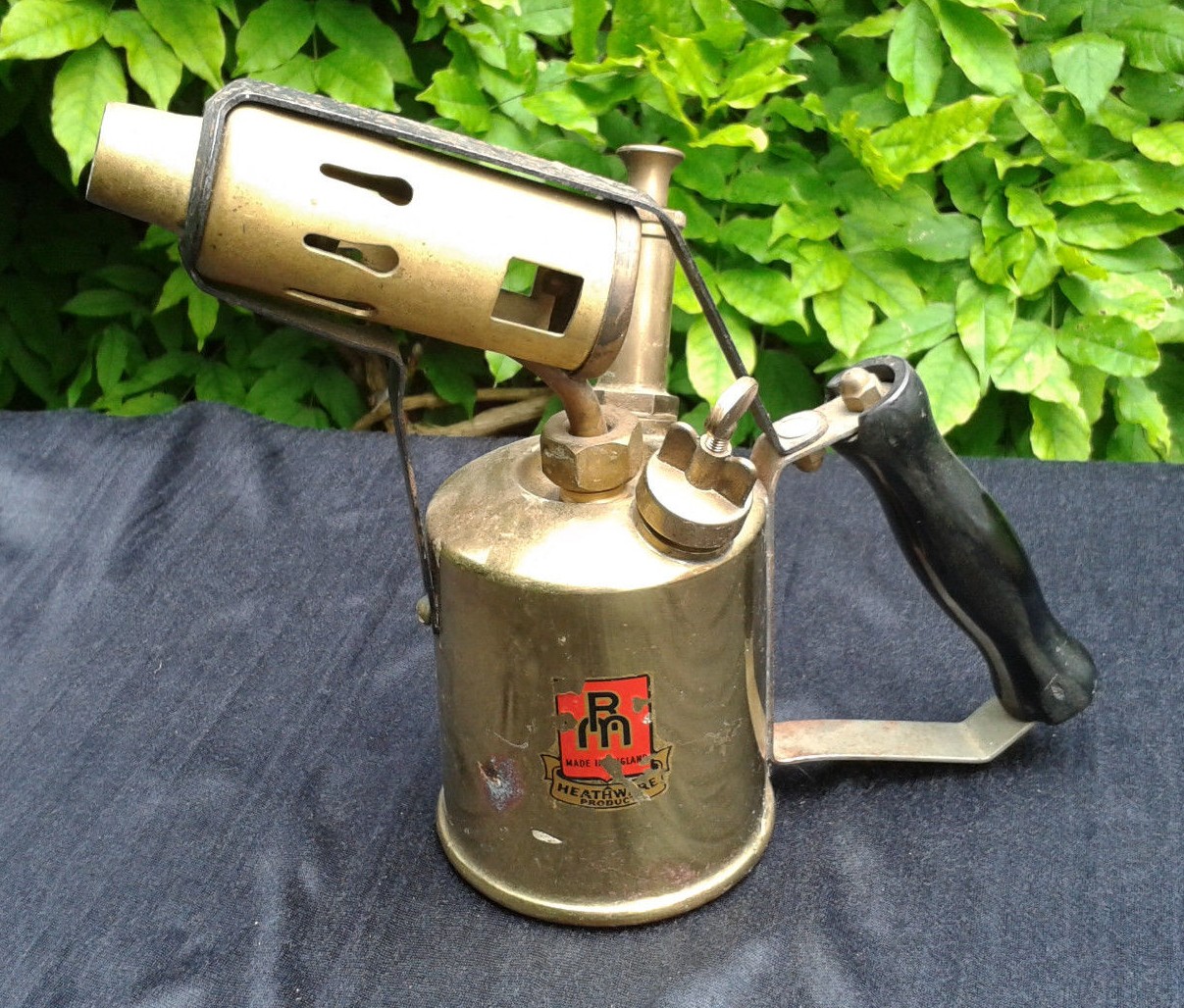
|
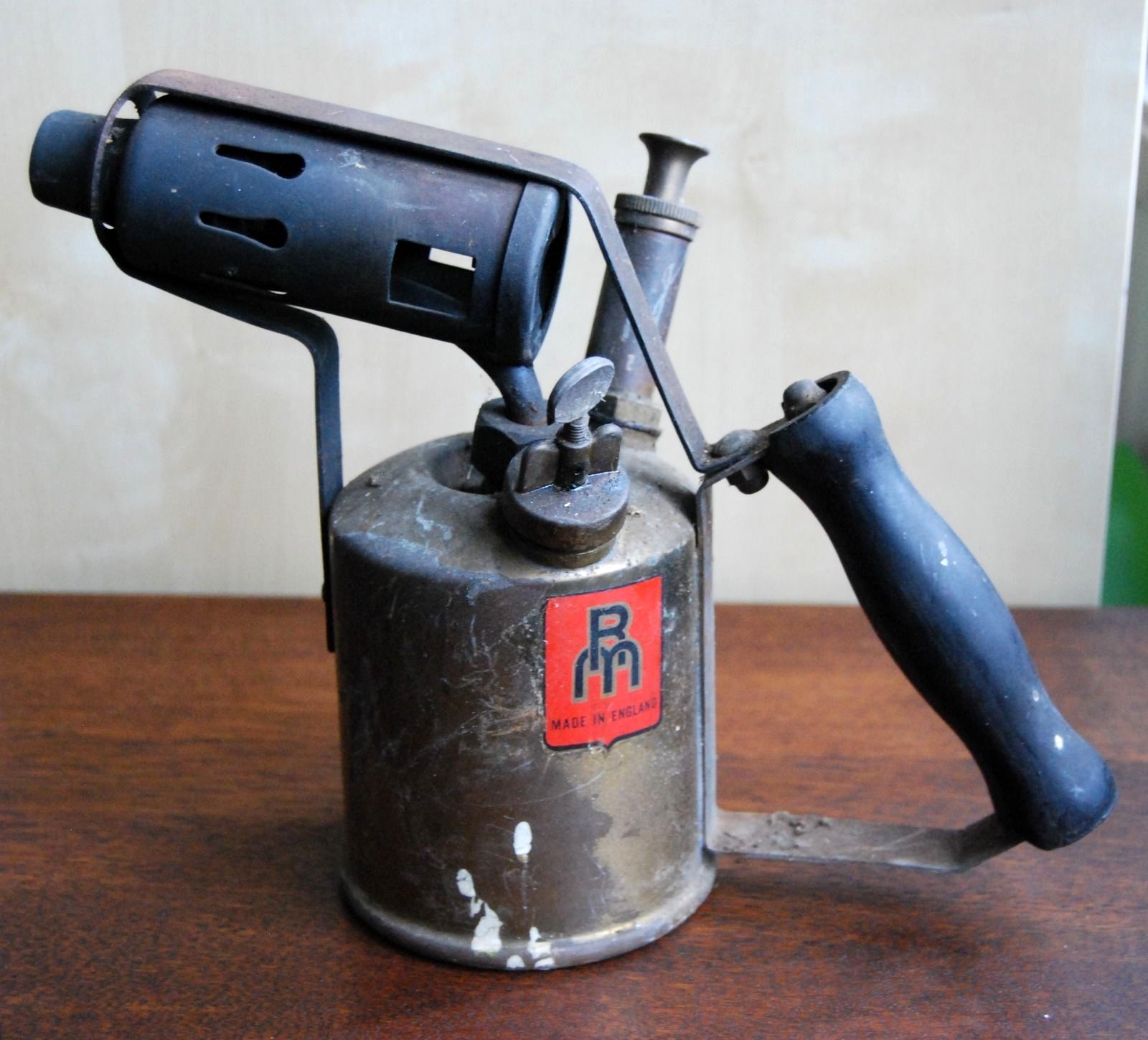
|
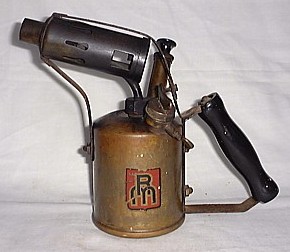
|
|
|
R M pint paraffin examples. Different forms of filler cap, and handle fixings to the tank, appear on pint models. On the examples above left and centre a combined filler cap and pressure release screw (similar to that on the half-pint models) can be seen. The example to the left has the additional "Heathware Product" name, click on photo to enparge. The example above right, as well as some of those illustrated in the advert (far right), could, without a label, be mistaken for pint models by Meads Brothers, Ludlow (Phoemax) although there is no known connection. |
RM & Thermidor (Samuel Heath & Sons) adverts dated between 1950 and 1960, click to enlarge. Note the two models shown are numbered 400L (pint) and 400S (half-pint). (Source, PHILIPPE TOUILLET Book of British Blowlamps) |
||
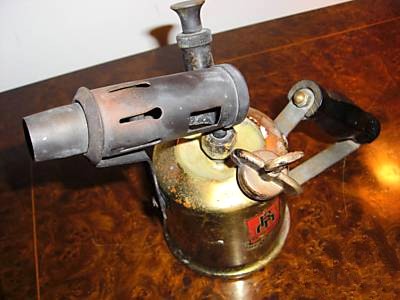
|
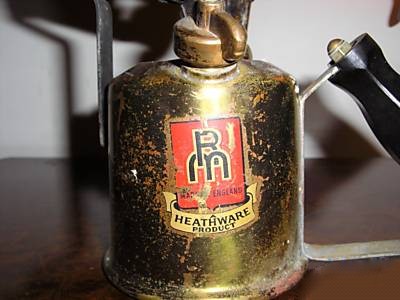
|

|
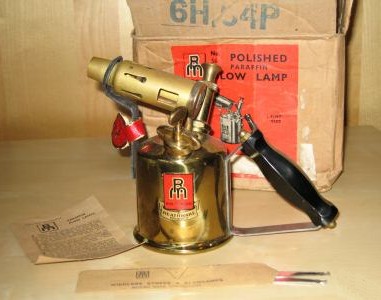
|
|
R & M Half-pint paraffin examples marked with the additional "Heathware Product" name, produced presumably after the takeover of R & M by Samuel Heath & Son in 1950. Half-pint examples are normally fitted with the distinctive combined filler cap and pressure release screw seen in the photographs. The example on the right is new, with box. Click on photo to enlarge. The bakelite handles were embossed with the initials R M, although it is thought not in all cases. See immediately below. |
|||
|
|
|
%20blowlamps-2.jpg)
|
|
|
R M paraffin blowlamp with vertical burner, with model number 2034 imprinted on the tank. If this is a "genuine" vertical burner model (as it has the appearance of being) then they are very rarely seen by the manufacturers discussed in this article. |
R M half-pint petrol blowlamps, according to the advert above right model 9345 / 9346. These petrol models were probably manufactured by Samuel Heath & Son and sold under the R M / Heathware name at some time after the takeover of R & M by Samuel Heath & Son in 1950. Note the R M type plastic / bakelite handle. See also the advert dated 1955 for Thermidor (Samuel Heath & Sons) below left. |
||
|
R & M Manufacturing & Engineering Co Ltd / Samuel Heath & Sons: Examples with Thermidor label |
||
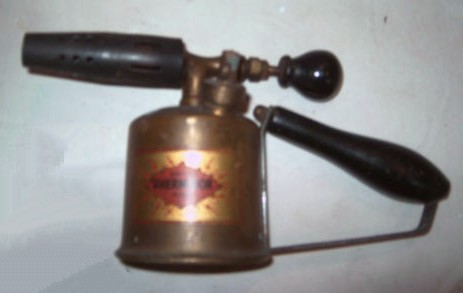
|
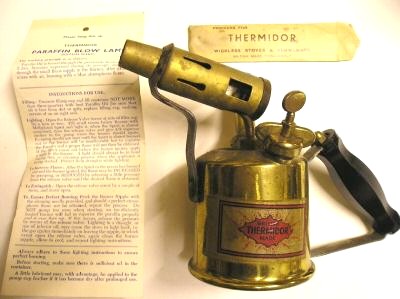
|
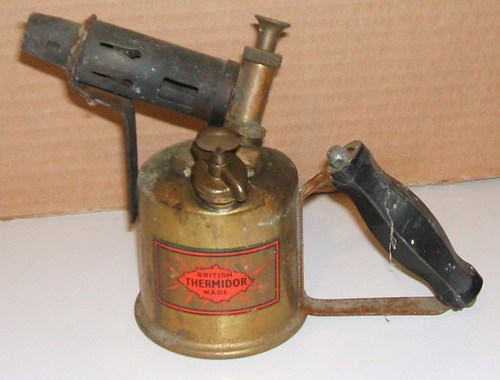
|
|
Petrol blowlamp with the Thermidor label (Samuel Heath & Son brand name). A model produced by S H & S and the same as the two examples immediately above right, except for the handle type, and in one case, the control knob. |
Half-pint paraffin examples with the Thermidor label (S H & S brand name), but clearly made by R & M Manufacturing, presumably at some point after they were taken over by S H & S in 1950. |
|
|
|
To the left is an advertisement (click to enlarge) dated 1955, for Thermidor (Samuel Heath & Sons) products. To note are the illustrations of the petrol blowlamp with the Thermidor label (as photograph immediately above left), a pint paraffin example as photographs shown below, and a half-pint example of R & M Manufacturing (type) as the two photographs immediately above right. This indicates that Samuel Heath & Sons were producing their own range of blowlamps, whilst R & M Manufacturing were still in production, said to be up to 1960? |
|
Samuel Heath & Sons The origins of Samuel Heath & Sons as brass founders can be traced back to c1820, originally as manufacturers of brass bedstead ornaments and candlesticks. Stove & blowlamp production started as early as c1918. As discussed, Samuel Heath & Sons bought out R & M Manufacturing & Engineering Co Ltd in 1950. A more detailed history of Samuel Heath & Sons would make a separate and interesting study. An excellent summary can be seen on the "The Oldcopper Website" https://oldcopper.org/makers/samuel_heath_co.php References to Samuel Heath & Sons Ltd and their connections with R & M Manufacturing (up to the present time) are to be found on the internet, for example: https://beta.companieshouse.gov.uk/company/00031942 |
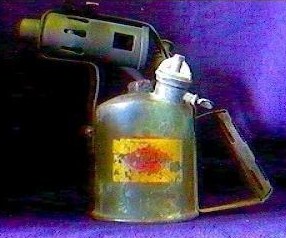
|
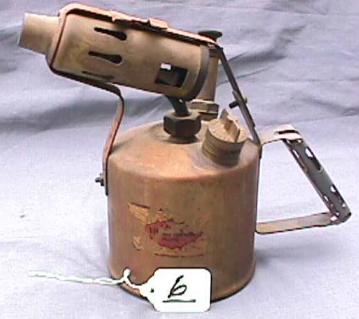
|
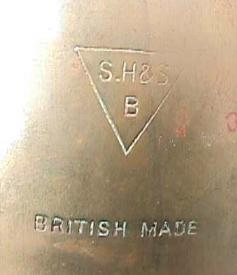
|
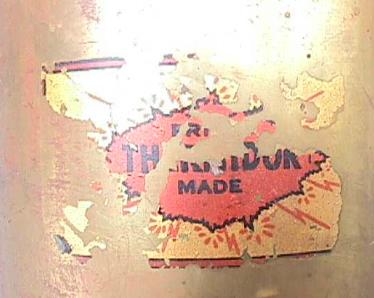
|
|
Pint, left, and quart paraffin examples with the Thermidor label, but clearly of Sameul Heath & Sons manufacture. Note the "S.H&S B" imprint in a triangle, in the tank of the quart example to its left. These examples were probably produced after 1950. |
|||
.jpg)
|

|
.jpg)
|
|
Two further pint paraffin examples with the Thermidor label, of Sameul Heath & Sons manufacture; again, probably produced after 1950.
|
||
|
R & M Manufacturing & Engineering Co Ltd / Samuel Heath & Sons: COB examples |
|||
|
|
|
|
|
|
Almost certainly an R M produced half-pint example with a COB label (BN98). |
Above is another example of a COB (brand) blowlamp, in this case made by Sameul Heath & Sons (S H & S). Most likely, COB was / were a distributor or retailer; was COB a trade / company name, or initial letters? |
||
|
Taymar Gas Ltd Manchester 3 / 100 Barbirolli Square, Manchester M2 3EY |
|||
|
Brand / Trade / Retailers Name(s): Taymax / Two Tiger (Fletcher Hardware) / Nordic? |
|||
|
Taymar Gas Ltd were thought to have formed in 1962, and to have ceased business in c1999. The company traded under the name G T Oaks (Tools) Ltd from when it started until 1977. They were described as being "manufacturers of other fabricated metal products". George Taylor Oakes, and other family members were directors; they also had interests in Coleman Taymar Ltd (formed 1950) and Epigas International Ltd (formed 1992). Taymar Gas, Epigas and Coleman Taymar were all involved in the production of butane type blow torches, stoves etc. Details are outside the scope of this article, but see examples below. Taymax blowlamps have a number of features in common with those of M H Berlyn Co Ltd (Parasene). Any connection should be regarded as tentative, though not ruled out entirely. The obvious difference is that Taymax blowlamps had bakelite / plastic handles, whilst M H Berlyn blowlamps were fitted with painted steel handles. See above. Two Tiger By all appearances, Taymar also supplied blowlamps for resale under the Two Tiger label by Fletcher Hardware Co Ltd, Edgbaston Road, Birmingham, a UK retailer and ironmonger supplier. See below. The Two Tiger trade name / logo is attributed to Fletcher Hardware; the "Ironmonger Diary" of 1922 describes "Two Tiger" hardware, though blowlamps are not specified at this time. Nordic Another blowlamp, which appears to have been produced by Taymar has been recorded with the name Nordic on a stick on label. See below. Wrights of Lymm Wrights of Lymm (considered retailers of blowlamps, rather than manufacturers) were said to have been agents for Taymax at one point. |
|||
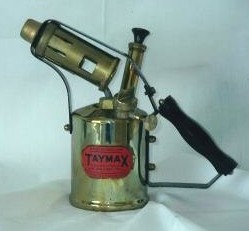
|
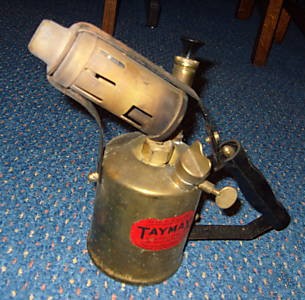
|
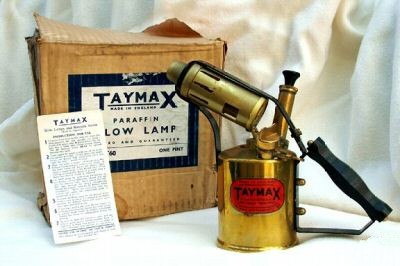
|
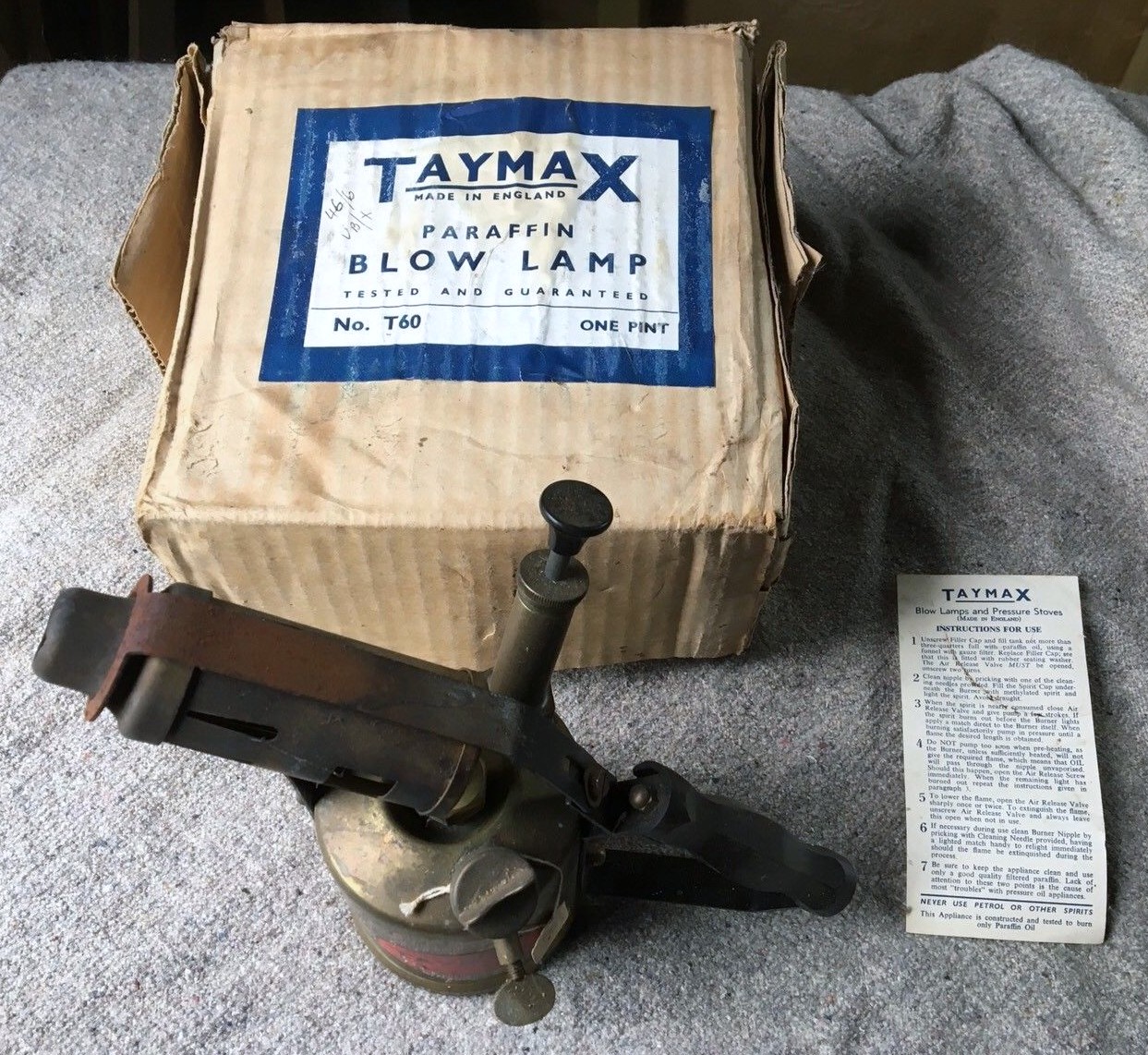
|
|
Examples of Taymar Ltd "Taymax" brand blowlamps. Note that apart from the bakelite / plastic handles, there are features of these blowlamps in common with those produced by M H Berlyn Co Ltd, notably the filler caps, the bakelite / plastic pump knobs, and the two piece burner of the pint models. As mentioned above, any connection between the two companies should be regarded as tentative. |
|||
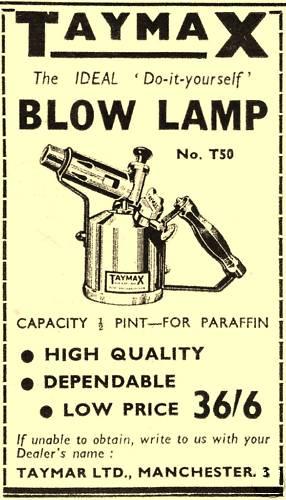
|
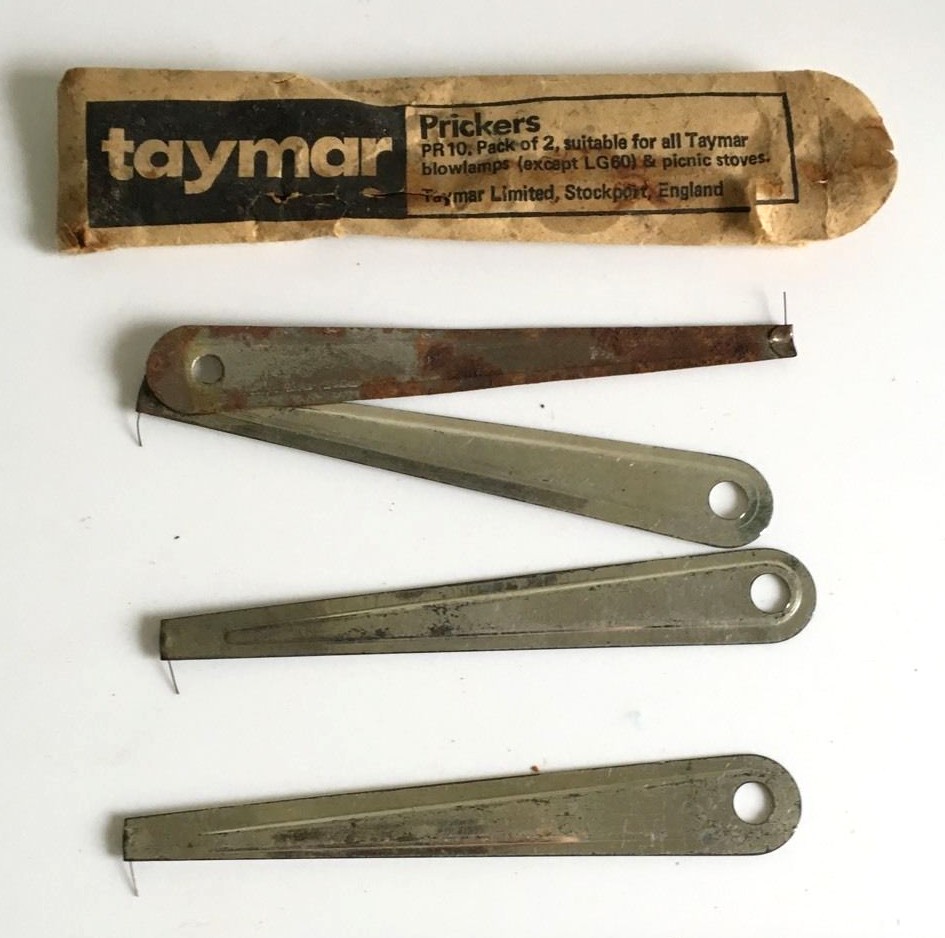
|
%20%20-%20a.jpg)
|
%20%20-%20b.jpg)
|
|
Taymar advertisement. Click on to enlarge. |
Taymar prickers |
Taymar "Taymax" butane blowlamp. Note the holder for the cannister has the bakelite / plastic handle as earlier paraffin models. |
|
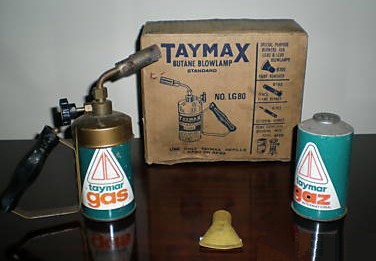
|
|
|
|
Another Taymax butane blowlamp. Again, note the holder for the cannister has the bakelite / plastic handle as earlier paraffin models. |
Coleman-Taymar butane / propane mix blowlamp |
Epigas butane blowlamp. Requires a gas cannister. |
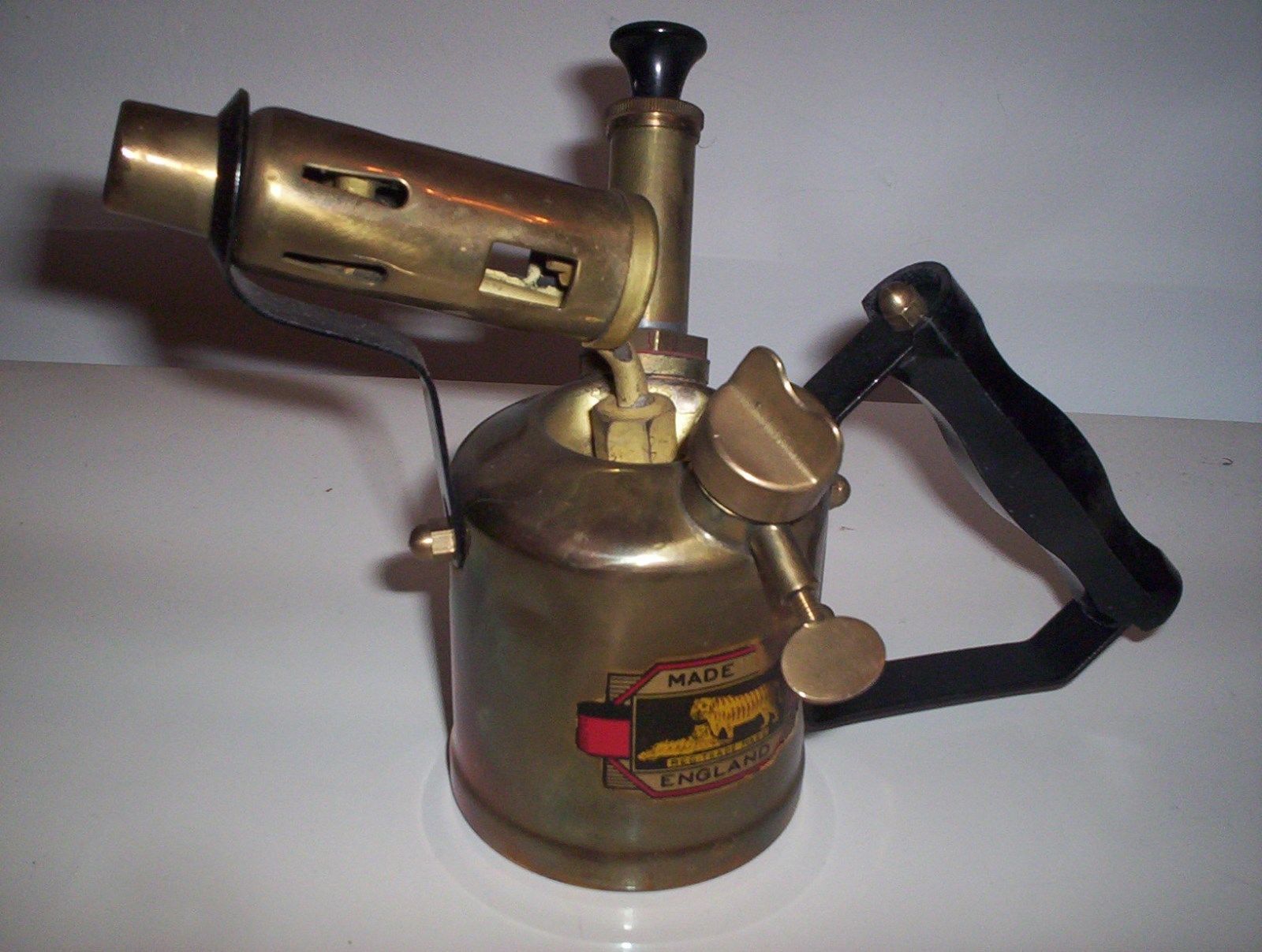
|
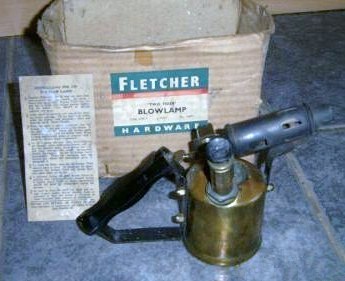
|
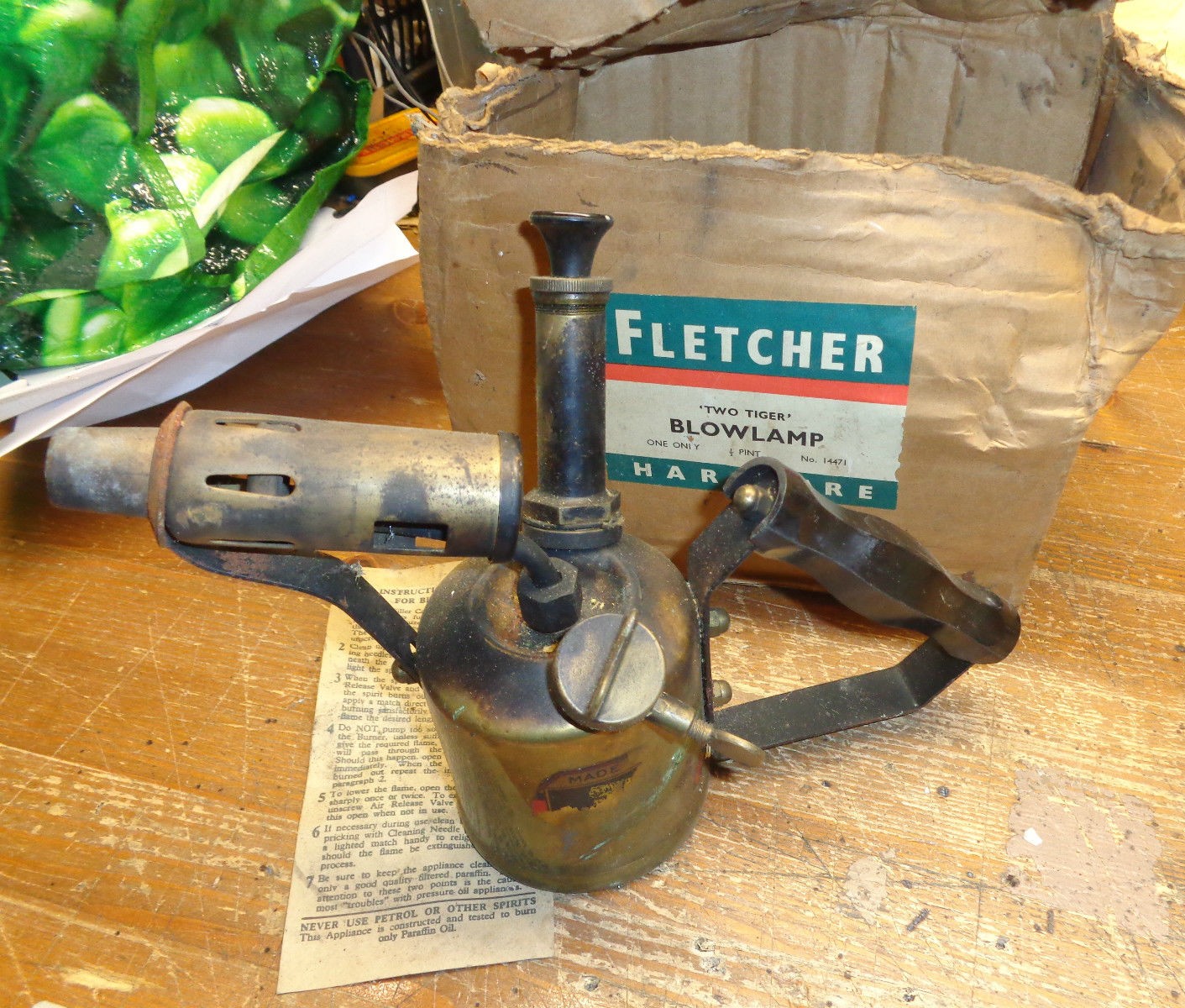
|
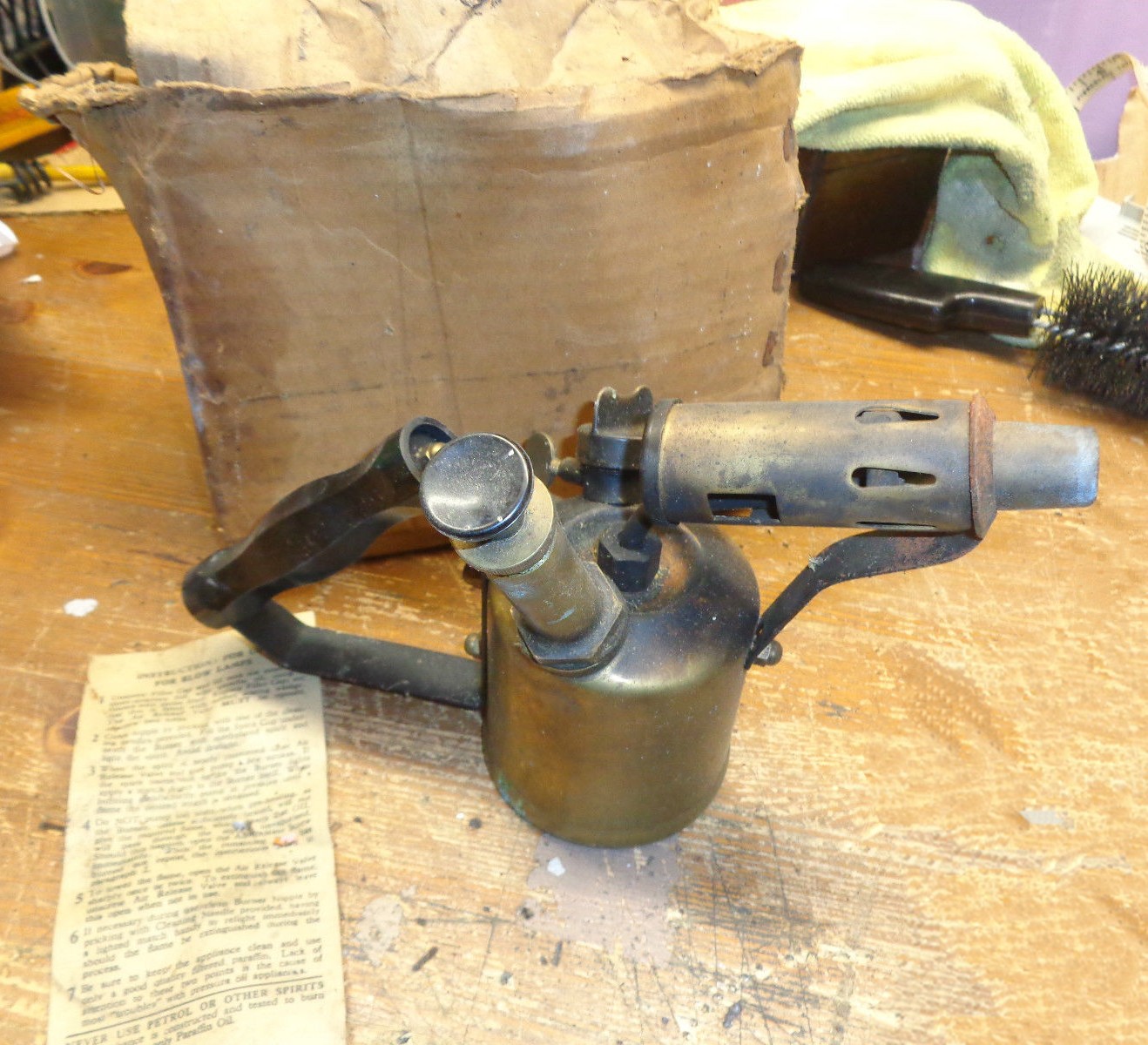
|
|
Further examples of Fletcher Hardware "Two Tiger" half-pint paraffin blowlamps. Note the Fletcher Hardware label on the boxes: Click to enlarge the two right hand photographs. |
|||
|
Taymar Gas Ltd: Example with the Nordic name |
||
|
|
|
|
|
Example of a "NORDIC" pint paraffin blowlamp. Almost certainly manufactured by Taymar Ltd, and presumably retailed / distributed under the NORDIC name. |
||
|
Appendix |
|
Falk, Stadelmann & Co Ltd (Falks Veritas). Works in London, Glasgow, Birmingham & Manchester, and branches in several locations throughout the British Isles. |
||
|
Brand
/ trade names Veritas, Falks, (possibly Nova?)
|
||
|
The Veritas / Falks range of what were standard paraffin blowlamps is thought to have been manufactured at various times by R & M Mfg & Engineering Co Ltd, M H Berlyn Co, and Meads Brothers, Ludlow. However, there are problems with the identification of some Veritas examples and their attribution to a particular manufacturer; for example there are to be found a number of variants with the name Veritas / Falks and the dates and range of models produced in each case is unclear. Falk, Stadelmann & Co were not thought to have actually manufactured blowlamps. |
||
|
Background Originally
the
German Veritas trademark had been owned by Jean
Stadelmann & Co and was acquired by Falk,
Stadelmann in London, initially for gas lamp mantles. The name Veritas
(or their logo, a "V"
within a trefoil shape) is seen on at least two models of small (early)
Swedish type petrol blowlamps, and a Swedish type paraffin example. See below.
These were the earliest known blowlamps to have appeared with the Veritas
name. For
further history see (for example) http://discovery.nationalarchives.gov.uk/details/rd/b5cebc36-0f18-4129-a064-ad0a20b9686e
(National Archives). The following is an extract: "Falk,
Stadelmann was incorporated as a limited company in 1887. The company
was based at 43, Farringdon Road, London, and is described in the Post
Office Directory of 1888 as glass manufacturers and importers of gas
fittings, paraffin lamps, glasses, chimneys, gas burners. They continued
to concentrate on the manufacture and supply of heating and lighting
equipment. The Company changed its name to Falks Ltd in 1962 and
again to Falks Industries Ltd in 1970. Subsidiary companies
included Falks Heating Ltd and Falks (N.Z.) Ltd (until 1951 known as
Welsbach Light Company of Australasia Limited)." http://www.gracesguide.co.uk/Falk,_Stadelmann_and_Co
https://aim25.com/cgi-bin/vcdf/detail?coll_id=13418&inst_id=118&nv1=browse&nv2=sub The name Falks has survived to more recent times (thought to be 2007) and butane fuelled blowlamps and camping equipment with the name Veritas Clansman or Highlander, for example, can be found. A note on pressure stoves: As
discussed, Falk,
Stadelmann & Co were
not thought to have actually manufactured blowlamps; but whether
or not they manufactured
pressure stoves is open to question. There is evidence, for example, that Meads
Brothers, Ludlow
manufactured
pressure stoves (as they did blowlamps) for Falk, Stadelmann, which
sold under the Veritas name. However, a full debate is outside the scope of
this article. Readers would do best to refer - for example - to the Classic
Camp Stove site for information. See http://classiccampstoves.com/ |
||
|
|
|
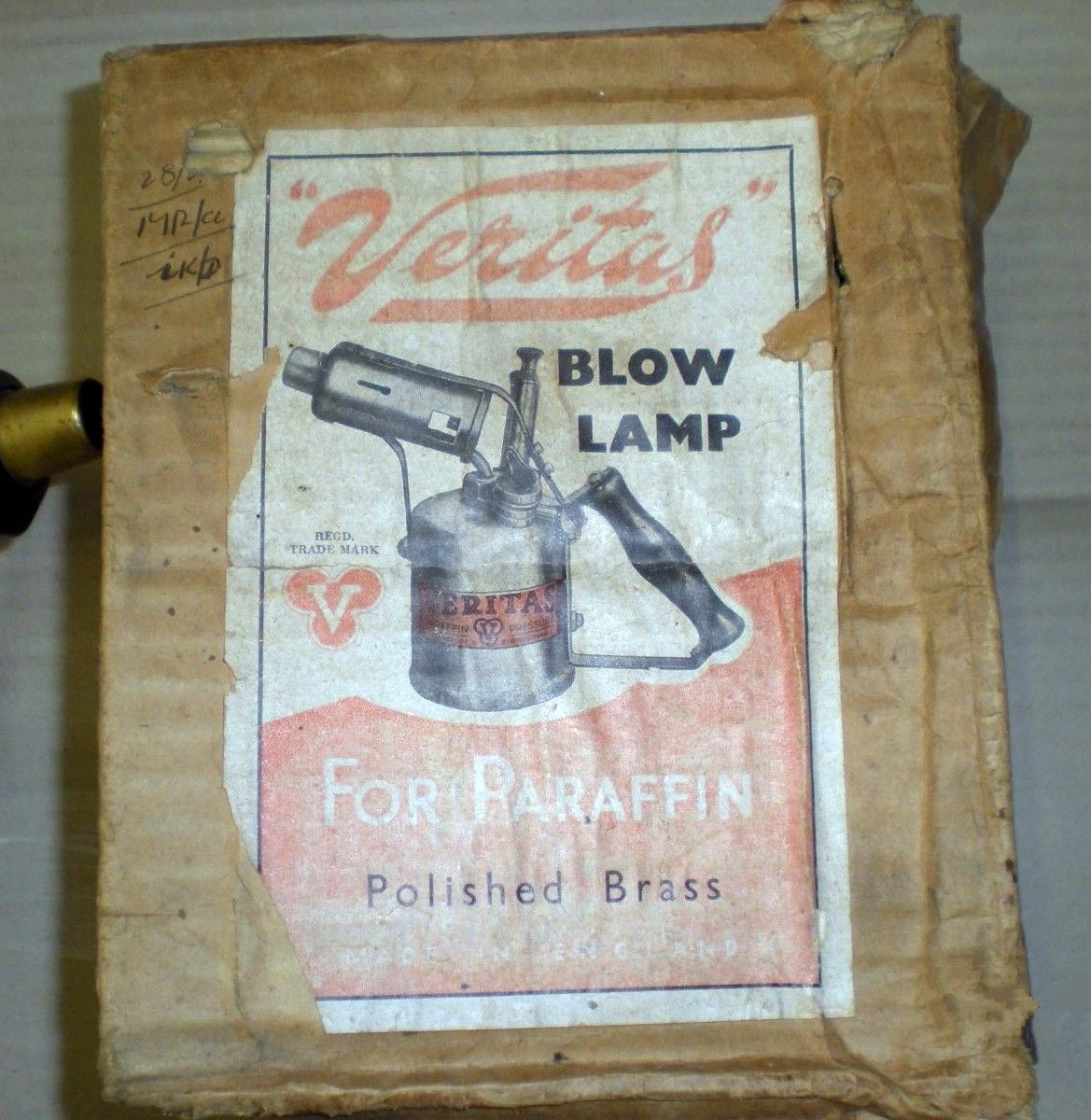
|
|
Veritas pint paraffin model (with bakelite handle) with all the appearance of being made by Meads Brothers, Ludlow (Phoemax) particularly as it has been reported that "Veritas blowlamps were made in Ludlow up until 1960". See above. These could have been amongst the earliest Veritas models produced. Note the "smoother" or more rounded contour to the bakelite / plastic handle on the pint models, similar to those produced by Meads Brothers. Some of these bakelite handles are said to have been embossed with the Veritas name. |
Box for a Veritas blowlamp, depicting the model shown to the left. Click on photo to enlarge. |
|
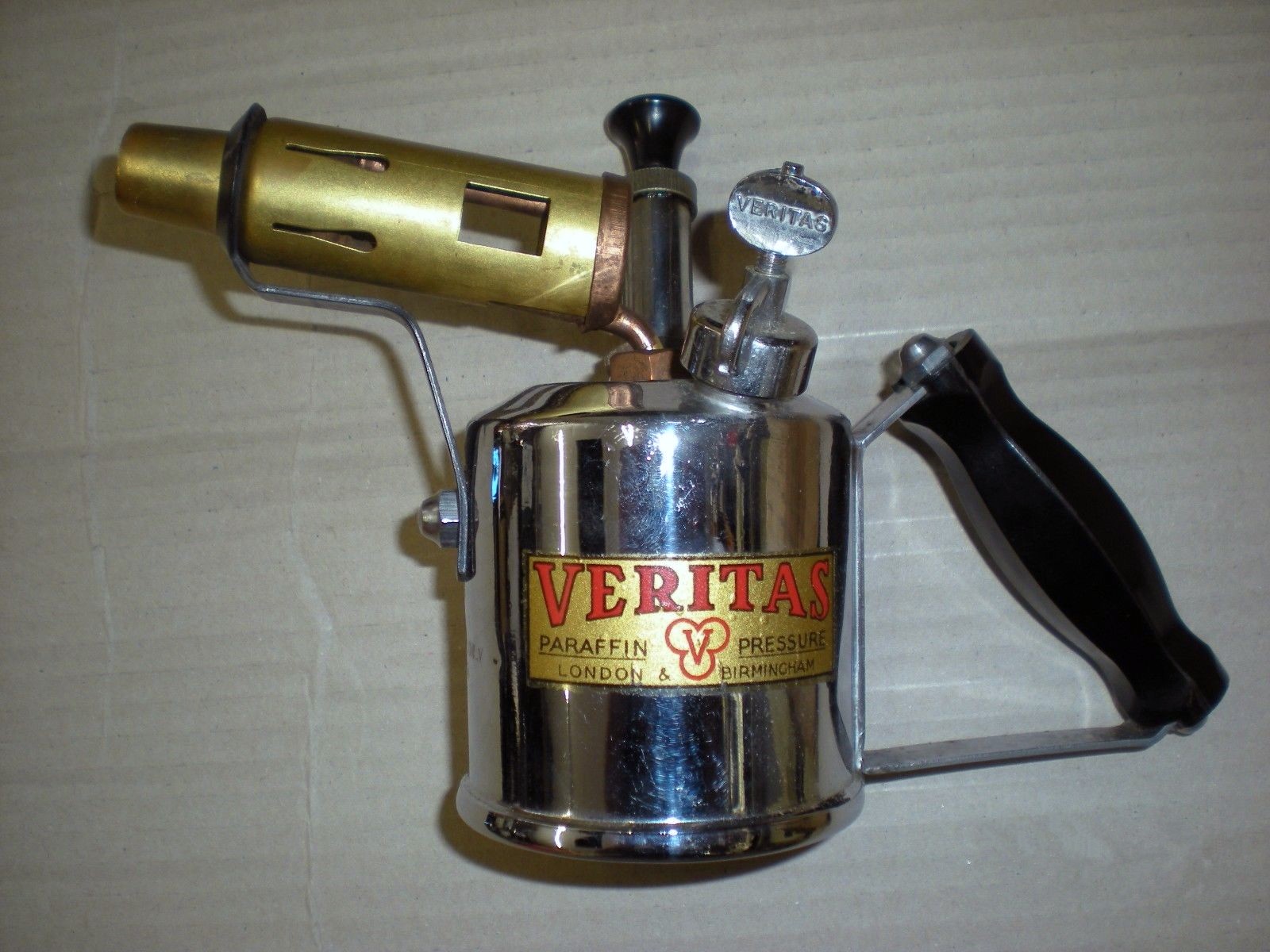
|
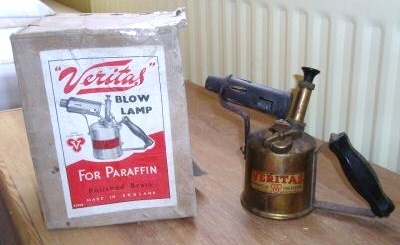
|
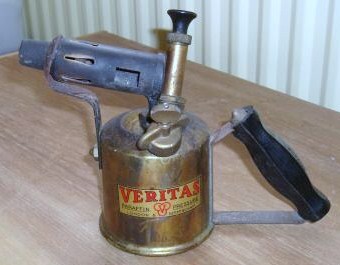
|
|
Veritas half-pint paraffin models, with the characteristic combined filler cap / pressure release screw, and bakelite handle, typical of the half-pint models produced by R & M Manufacturing & Engineering Co. See above. Note the example on the left which has a chrome plate finish (click on photo to enlarge). The pressure release screw has "Veritas" impressed into it. |
||
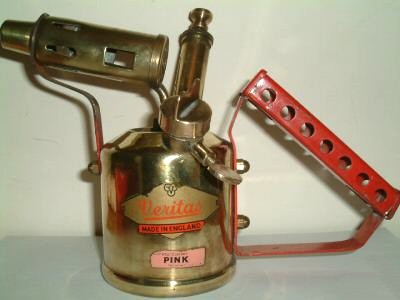
|
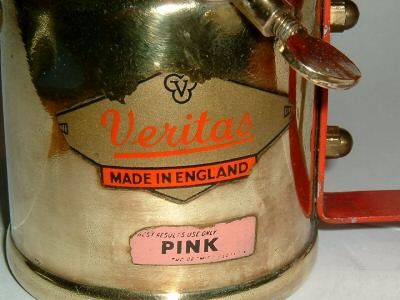
|
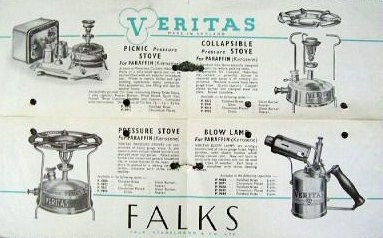
|
|
Veritas half-pint paraffin model with the appearance of having being produced by M H Berlyn Co (Parasene), except for the red paintwork, as opposed to black. Also the pump knob is brass rather than the characteristic bakelite / plastic type on Parasene models. See above. |
Veritas / Falks leaflet, said to be dated 1950. The pint blowlamp to the right has the bakelite / plastic handle, and is the same as that shown above. |
|
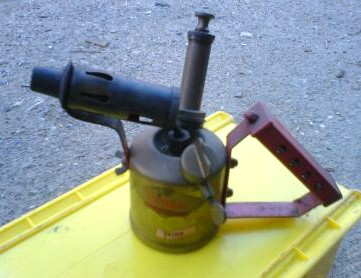
|
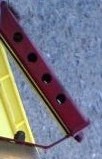
|
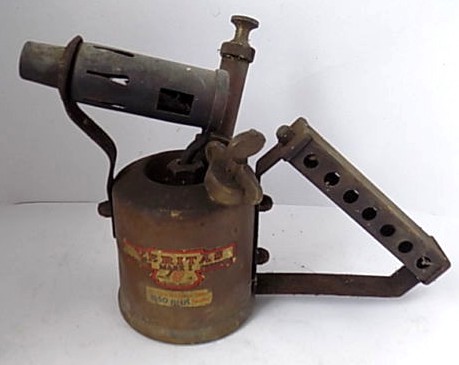
|
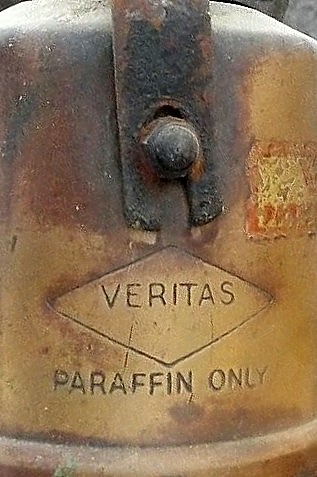
|
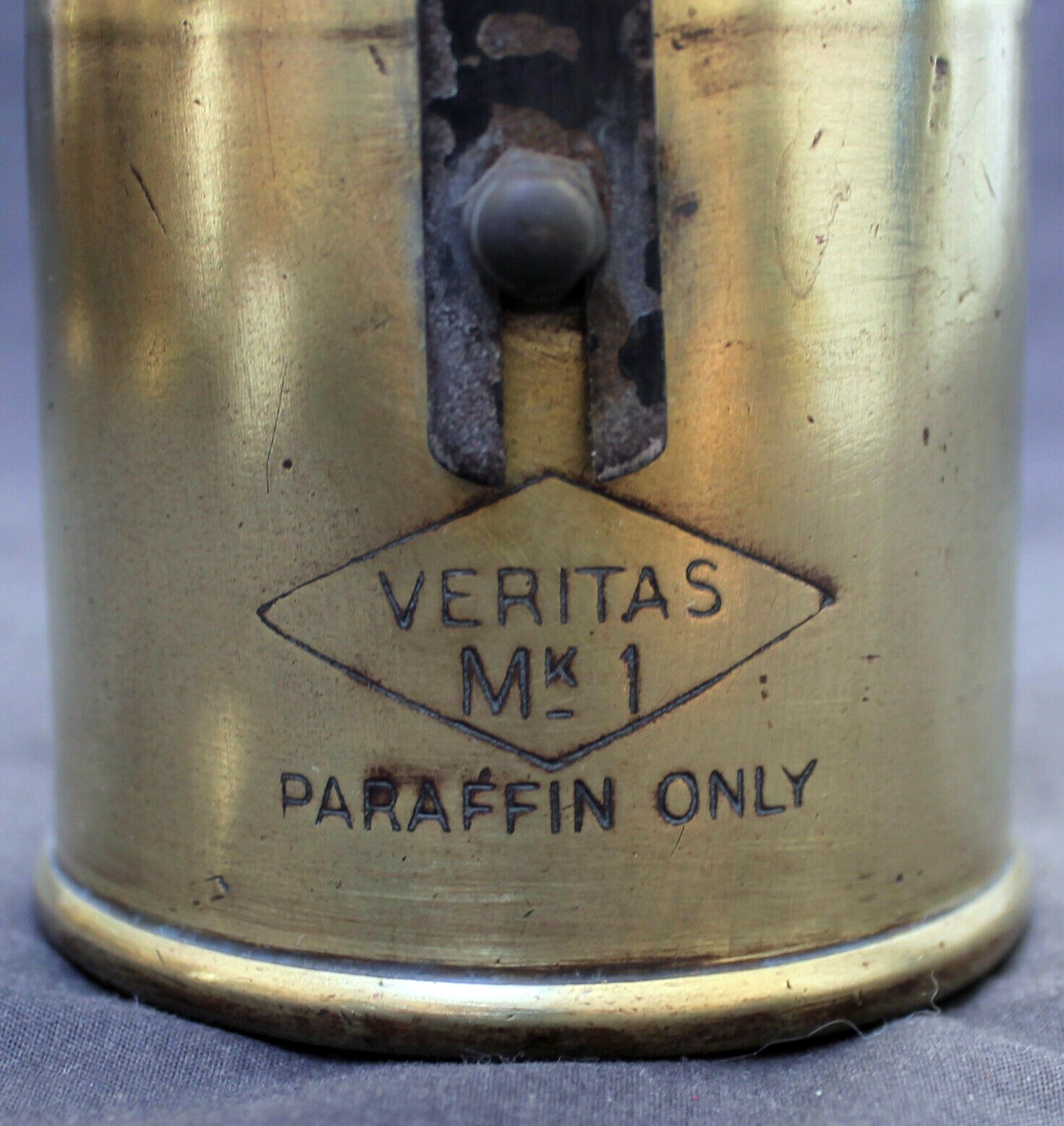
|
|
Half-pint Veritas model which has the appearance of being made by M H Berlyn Co. (Parasene) but note the handle fixing with a spindle through its length, with domed nut at each end and, curiously, only four holes as opposed to the normal seven. Note also the "Moon & Stars" pint example (M H Berlyn Co) with the same handle type, above. On Parasene examples the handles were black painted, the ends were said to have been closed with spot welds, and the usual seven holes are found. See above. |
Another Veritas oddity. As with the example to the left, the handle has the same spindle fixing, but the normal seven holes. The combined filler cap / pressure release screw is almost certainly that produced by R & M Manufacturing, but note the Veritas logo stamped into the tank on this example. Of interest is that a very similar imprinted logo for "Phoemax" (Meads Brothers, Ludlow) can be seen. See above, suggesting a link between Phoemax and Veritas. |
Another example of a Veritas logo stamped into the tank. This time with the addition of "Mk 1". |
||
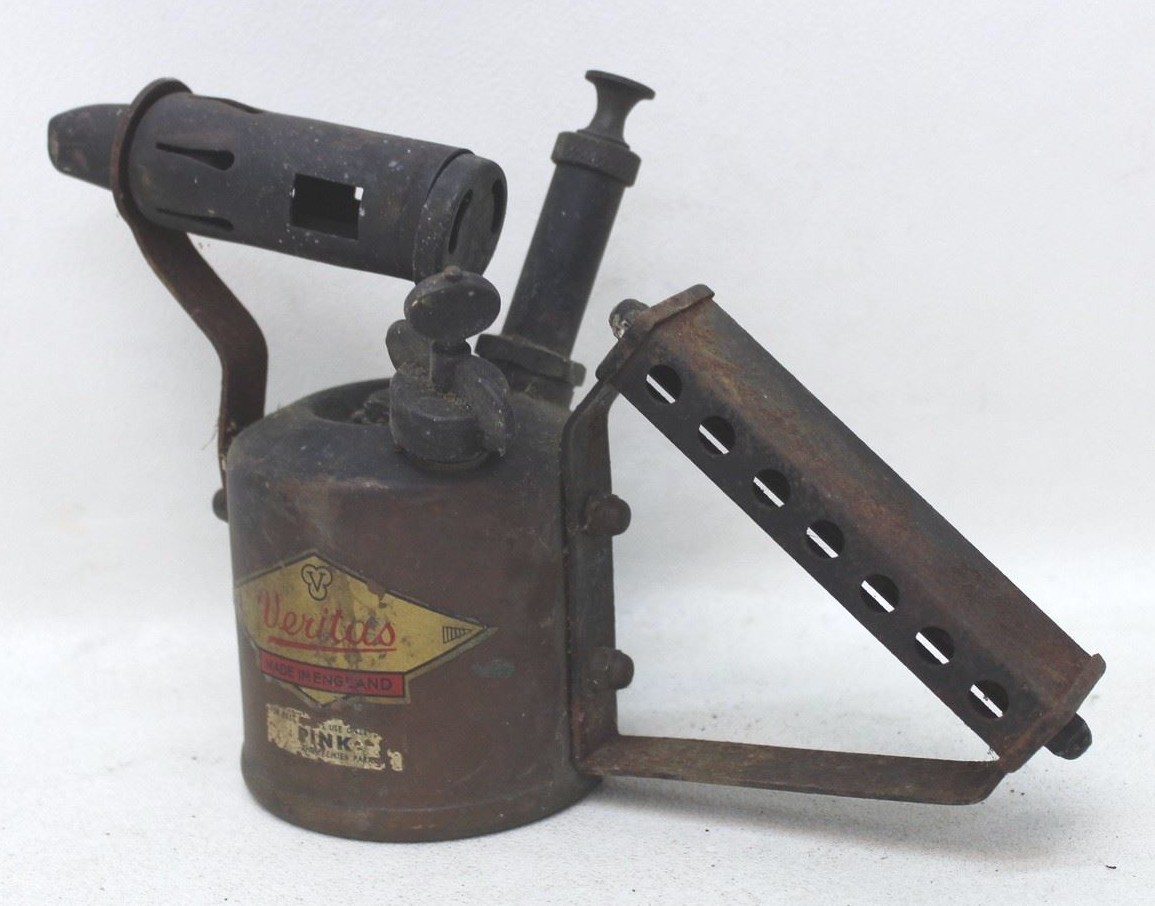
|
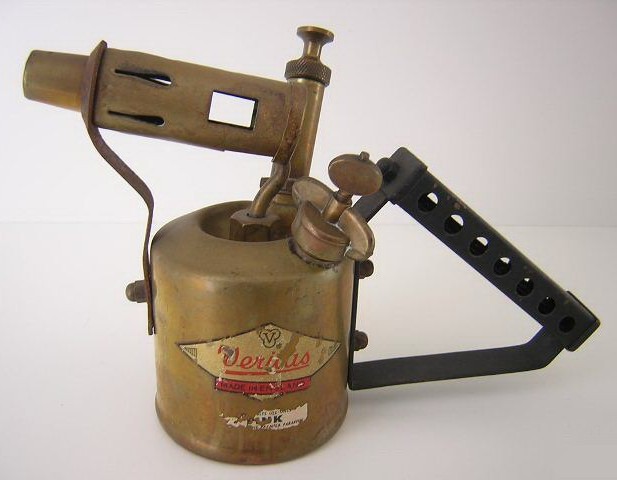
|
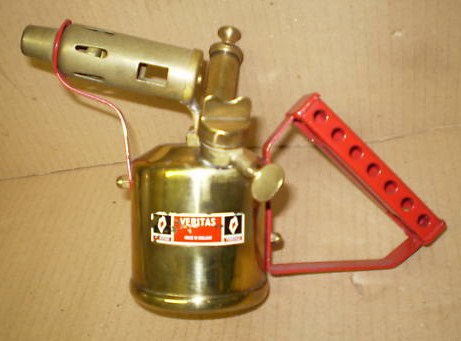
|
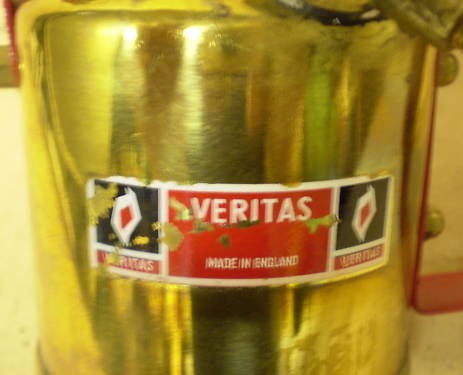
|
|
Two more Veritas half-pint examples, both almost identical to the half-pint example shown immediately above centre, except for a variation in the label. As has been said, the combined filler cap / pressure release screw on these two examples is almost certainly that produced by R & M Manufacturing; however, the origins and manufacturer of the type of steel handle with the spindle fixing are unclear. |
Presumed later (?) model of half-pint paraffin Veritas, with revised logo. Again, this has every appearance of having being produced by M H Berlyn Co (Parasene), apart from the red painted handle. Whether or not the red painted handle (and burner support bracket) was a feature of later Veritas models is open to question. Not many examples are seen with this red colour scheme. |
||
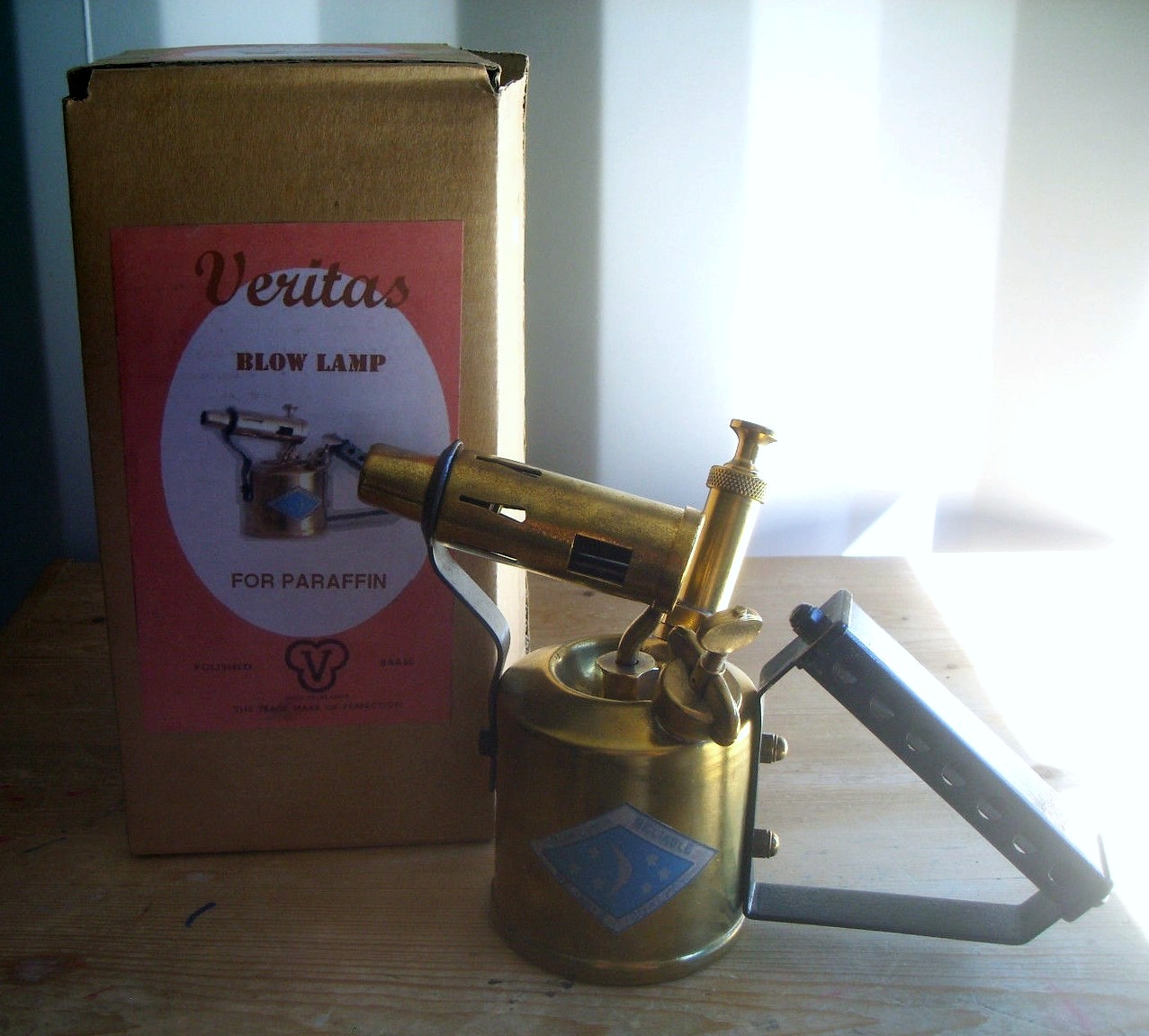
|
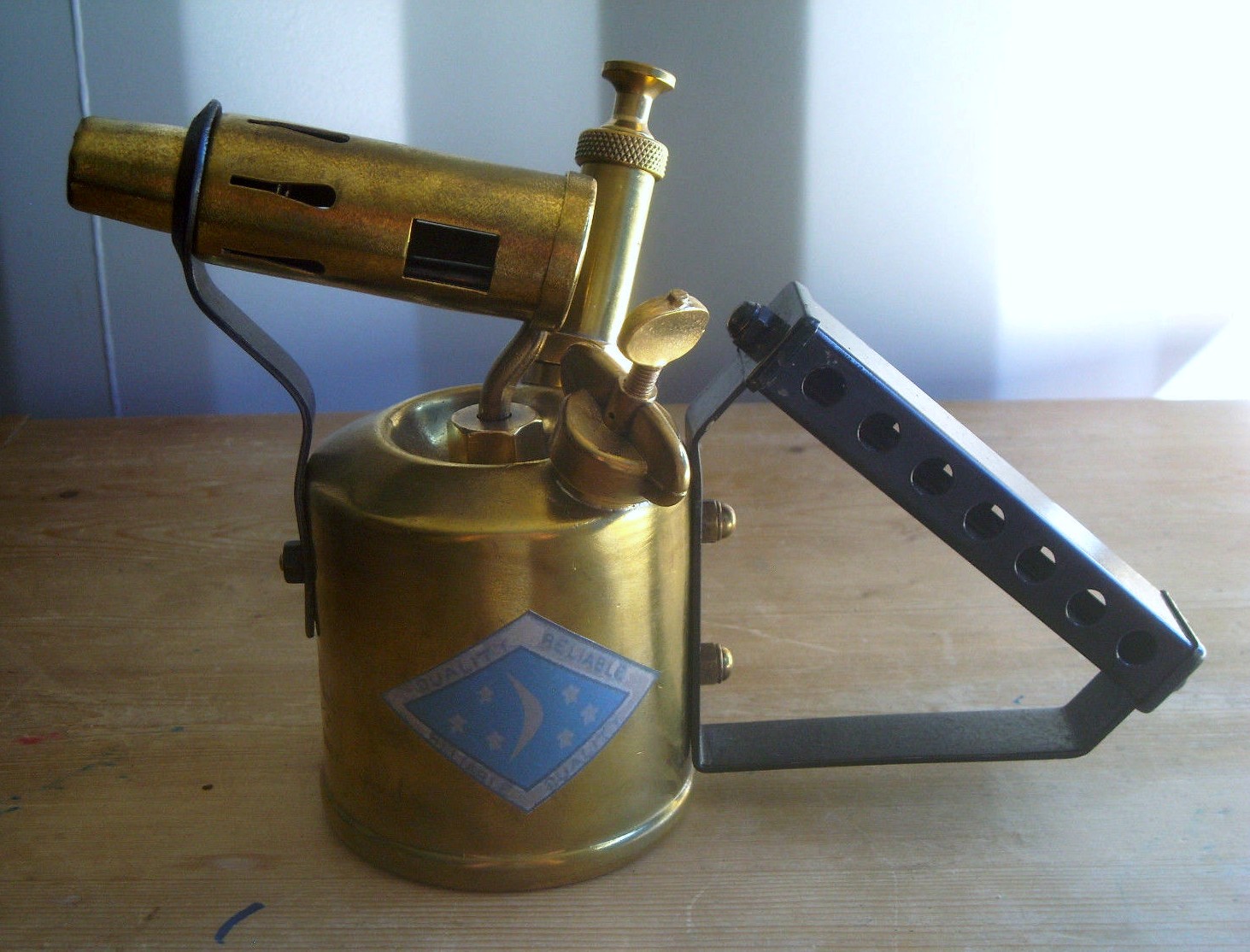
|
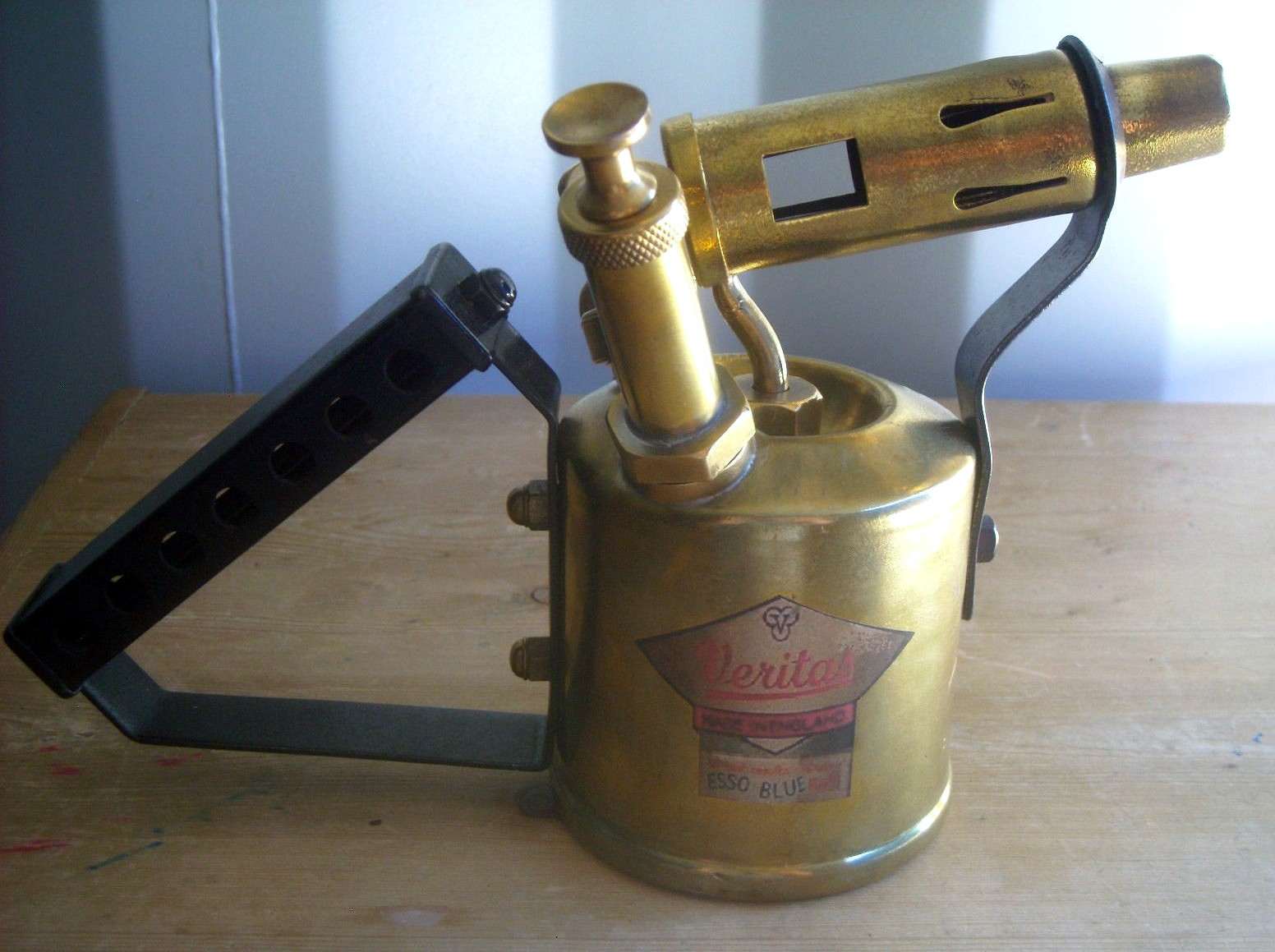
|
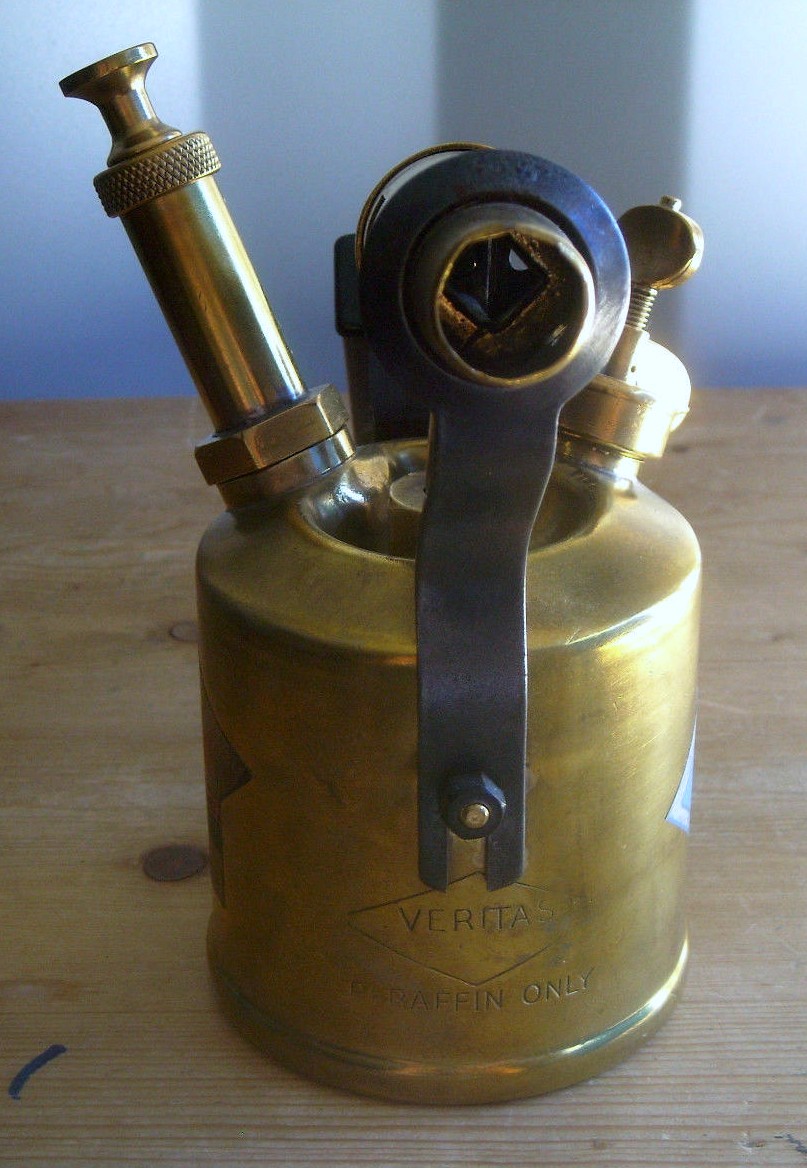
|
|
This half-pint Veritas is another anomaly. Again, identical to a number of the examples directly above. but with the addition of the "Moon & Stars" logo. Click on left hand photo to enlarge. Blowlamps with the Moon & Stars logo are associated with M H Berlyn Co Ltd. See above. |
|||
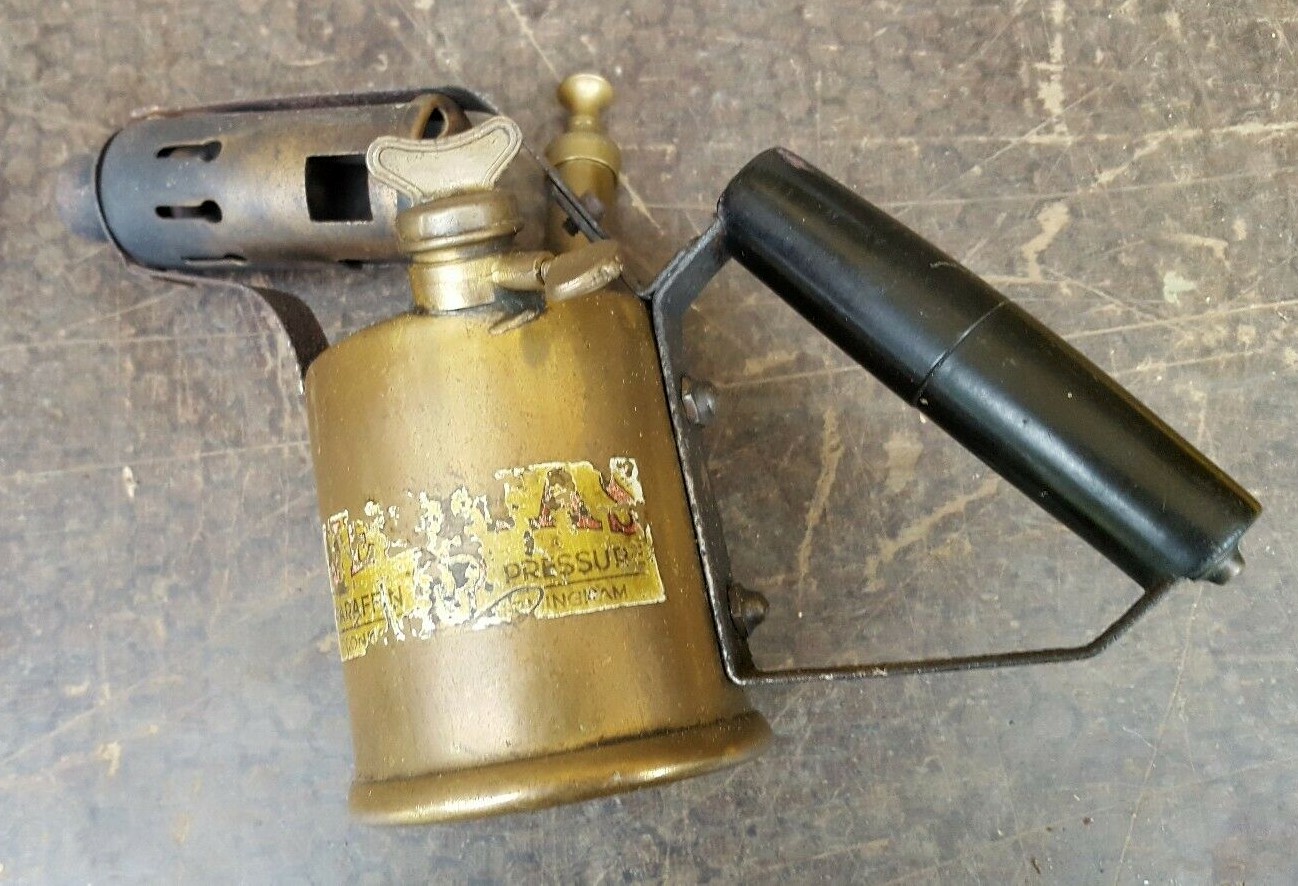
|
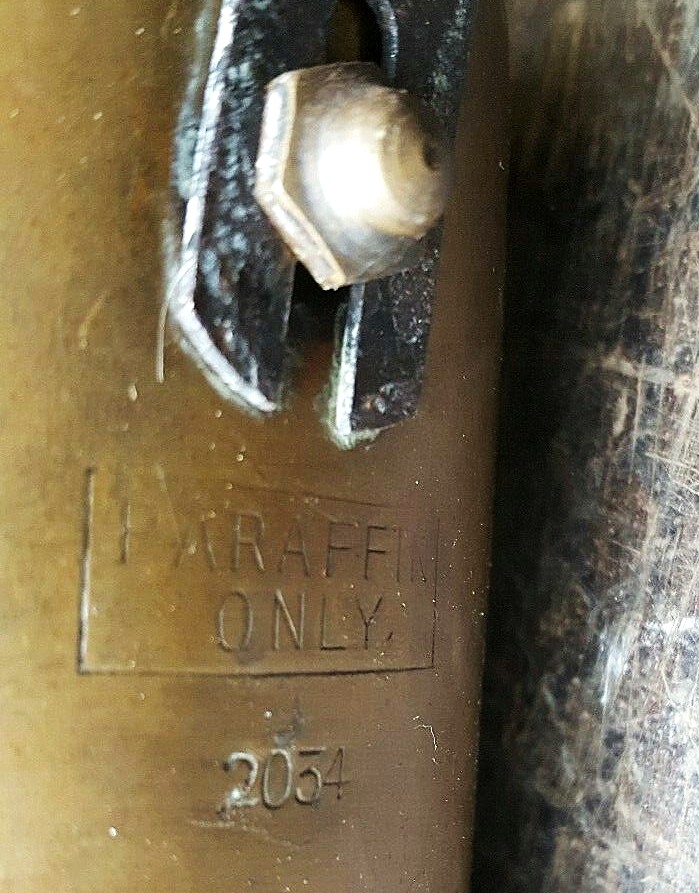
|
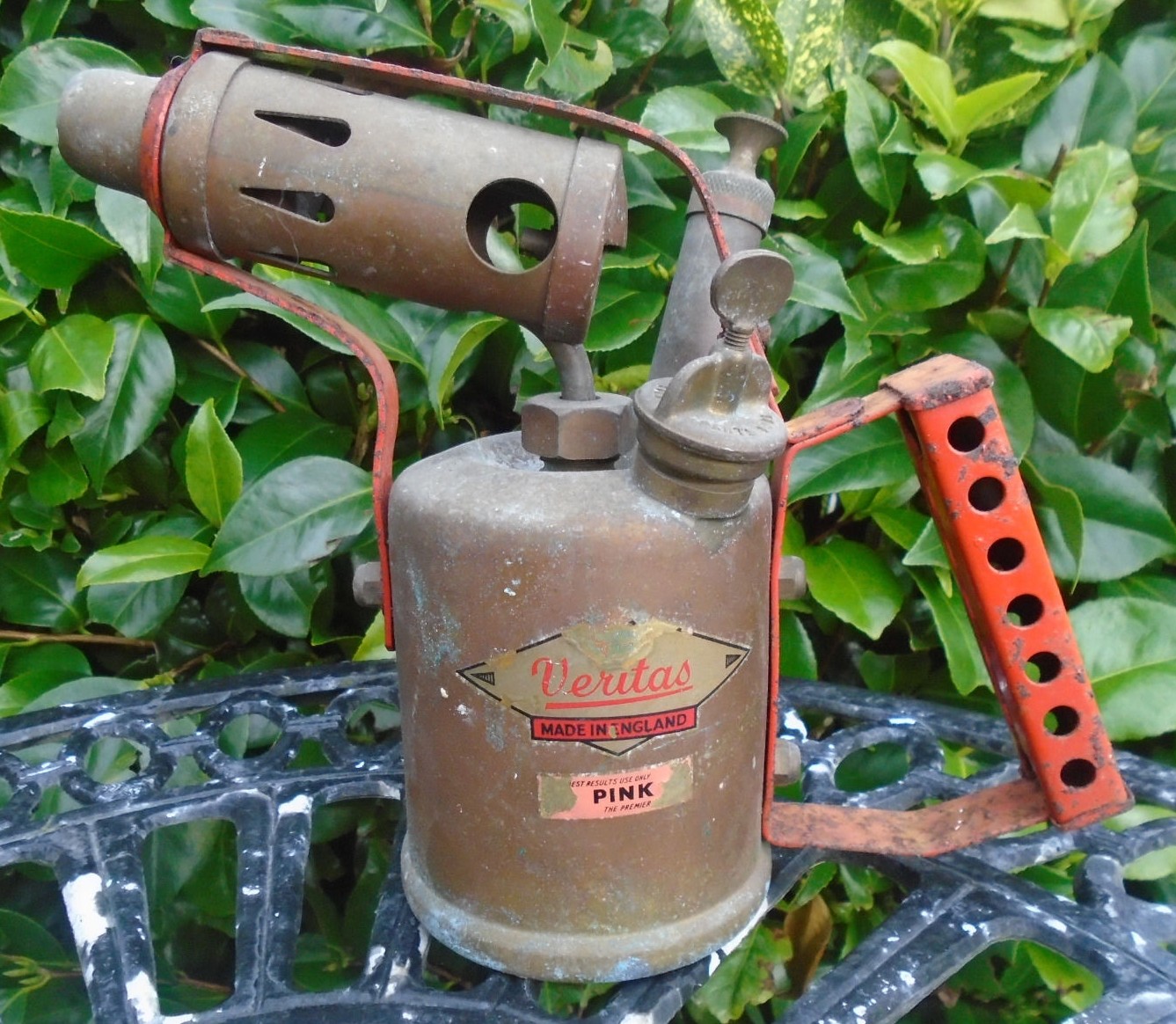
|
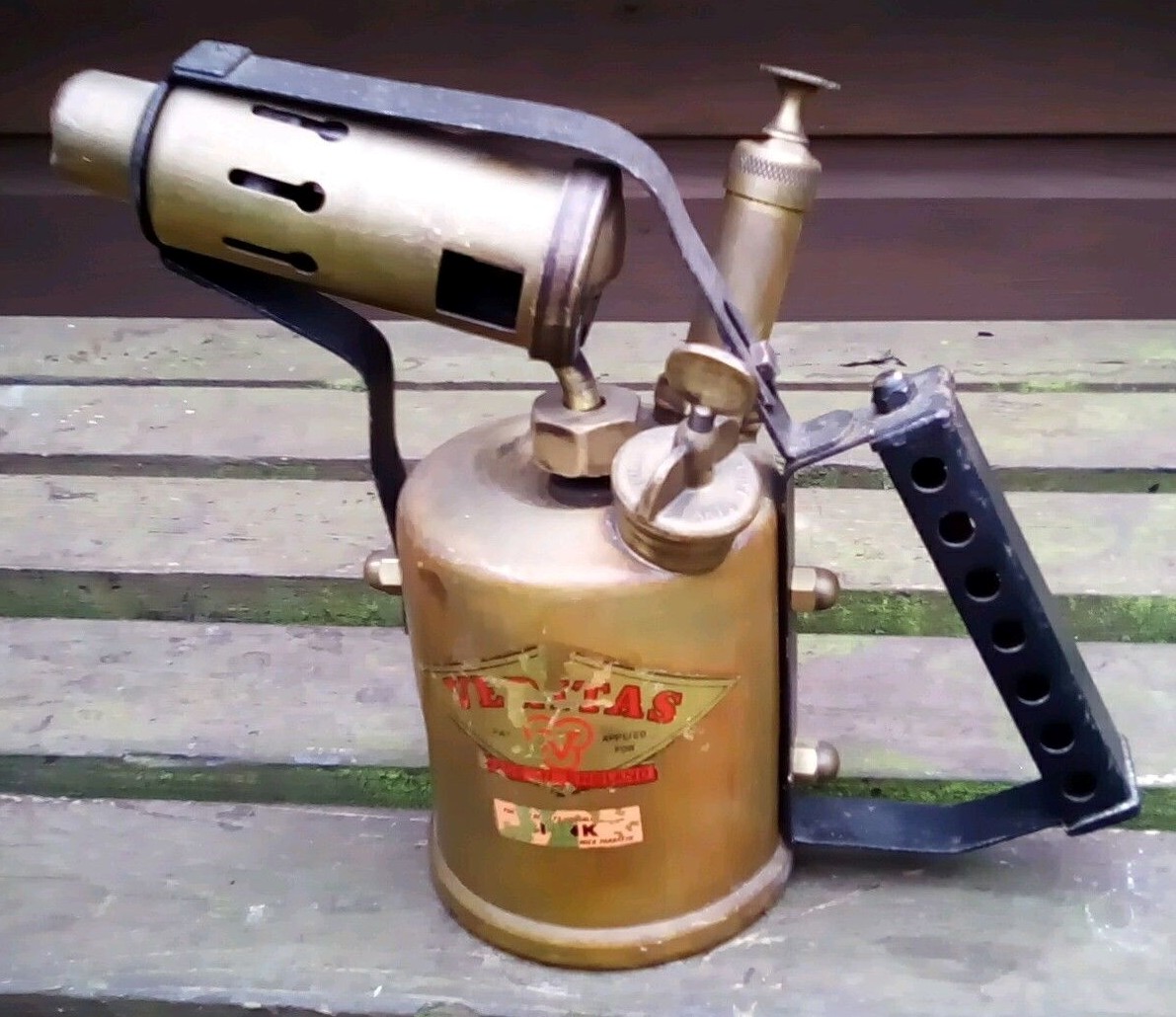
|
|
Another Veritas pint paraffin example. This time with a noticeably different form of handle, and the number 2034 impressed into the tank. Interestingly, there is an identical example by R & M see above suggesting a strong link between R & M and Falk, Stadelmann & Co Ltd (Veritas).
|
This pint paraffin Veritas is yet another variation. The red handle is of an odd form; there is a combined filler cap / pressure release screw similar to R & M, and an unusual burner tube. |
Another pint paraffin Veritas. The black handle is as the red version immediately left, but the fixing is with the spindle through its length, with domed nut at each end. Again, there is the combined filler cap / pressure release screw similar to R & M. |
|
|
Acknowledgements, and thanks to: PHILIPPE TOUILLET Book of British Blowlamps. Classic Camp Stoves website http://classiccampstoves.com/ Classic Pressure Lamps website https://classicpressurelamps.com/ Grace's Guide to British Industrial History http://www.gracesguide.co.uk/Main_Page The Terrence Marsh Lantern Gallery http://tgmarsh.faculty.noctrl.edu/uklant.html Espacenet, European Patents Office https://worldwide.espacenet.com/?locale=en_EP The Oldcopper Website https://oldcopper.org/ Blowlamp Society http://www.blowlampsociety.com/ Issues of Blowlamp News: Notably: BN17-p4; BN28-p5; BN34-p2; BN35-p4; BN45-p1; BN98-p8. Editions of Blowlamp News can be referred to on the Blowlamp Society website. |
|
Copyright: A note from the author. For articles such as this, where it is impractical to gather all the information from primary sources, much of the material, including a number of illustrations and photographs, is sourced from the Internet. However, such information, from whatever source, should not simply be "cut and paste" (unless clearly noted as such, and acknowledged). Copying such "blocks" of information is effectively plagiarism; it can take such information out of the context in which it was originally intended, which can mislead and sometimes compound errors. Where possible, the principle of "fair use" of information is herewith employed. However, copyright laws do exist for very good reasons, and the owner of photographic or written material has every right to object to its "re-use" for whatever reason. If anyone objects to the use of any information or illustrations within this article, or indeed anywhere on this website, please make this known and it will be rectified as soon as possible. |
|
© 2020 Blowlamp.co.uk. All Rights Reserved. |
|
31 May 2020, First published |